 |
Our Big Trans-Siberian Train Ride from London to Shanghai
October 2005
|
Part 1 - our route in Europe, stopping in Brussels, Minsk and Moscow
|
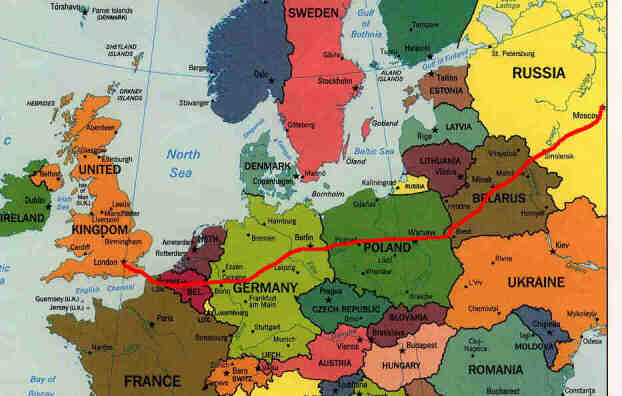
|
Our train tickets from London to Brussels, Minsk and Moscow.
|
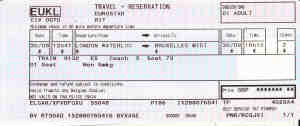
|
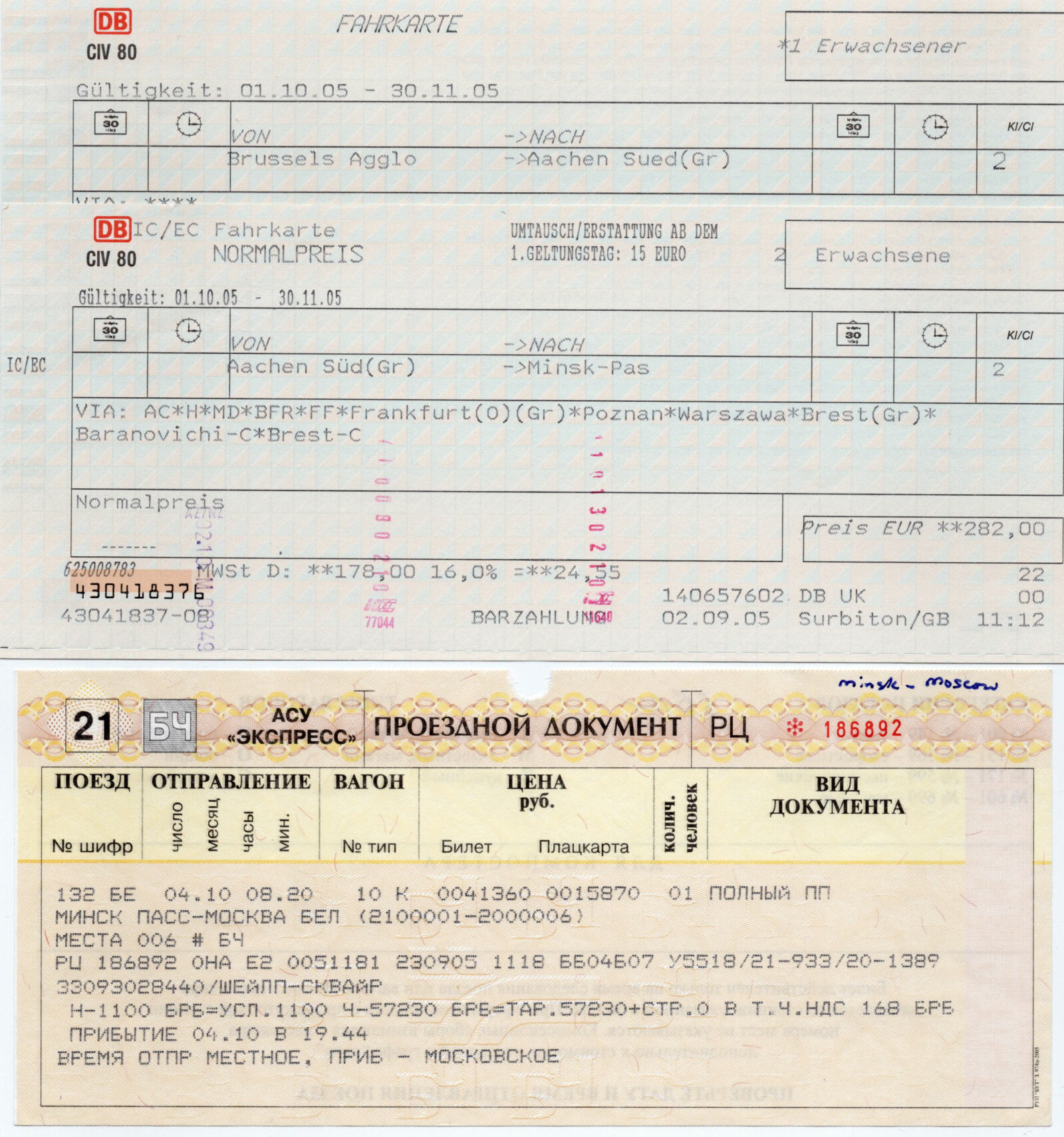
|
Brussels, Belgium
(and Germany and Poland)
|
Friday 30th September. We walked down the road from our house to the railway station and caught the train to Shanghai. Not one train all the way of course - we could have done it in five trains (London, Brussels, Moscow, Beijing and Shanghai) but we stopped in some other places along the way to sightsee. As we sat in the Eurostar departure lounge at Waterloo having a coffee with our baggage spread around us it started to feel as though the journey had begun. The Eurostar train took us to Brussels where we went to the Flores Grand Place, a small hotel just off the Grand Place which used to be the Sema Hotel when we stayed there on previous trips to Brussels. Sadly it was looking a bit run down but we still liked it. We walked around dodging the rain showers and had a couple of Leffe Brune beers and a lovely Ardennes paté at a café on a nearby square, then a very nice Flemish stew at the Raphael restaurant.
Sat 1st October. We slept really late and the buffet breakfast at Flores hotel was a bit of a fiasco because everything had run out, but if we waited long enough they brought refills. The weather improved and we had a nice few hours walking round the shops ....
|
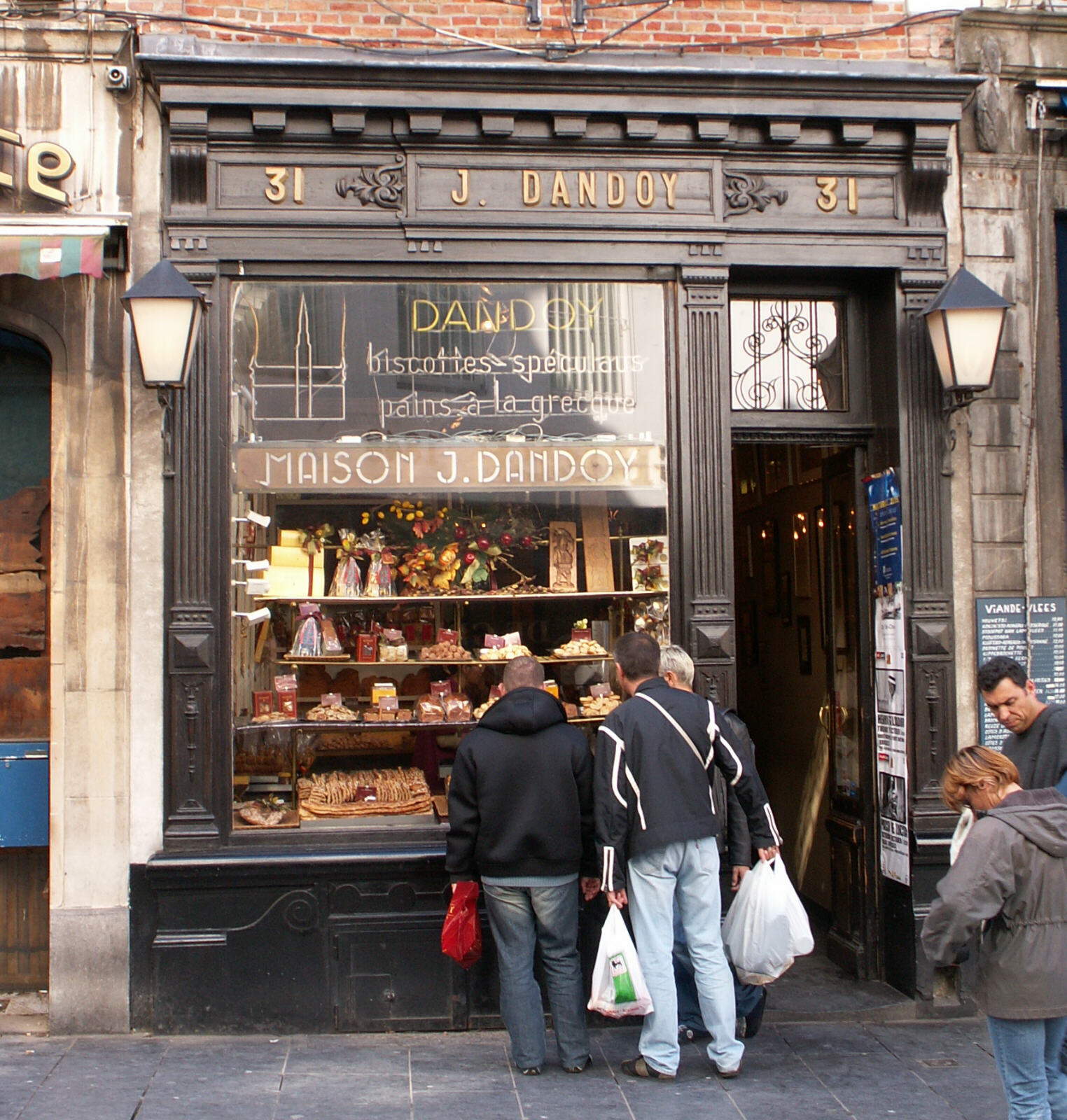
|
.... and the Grand Place.
|
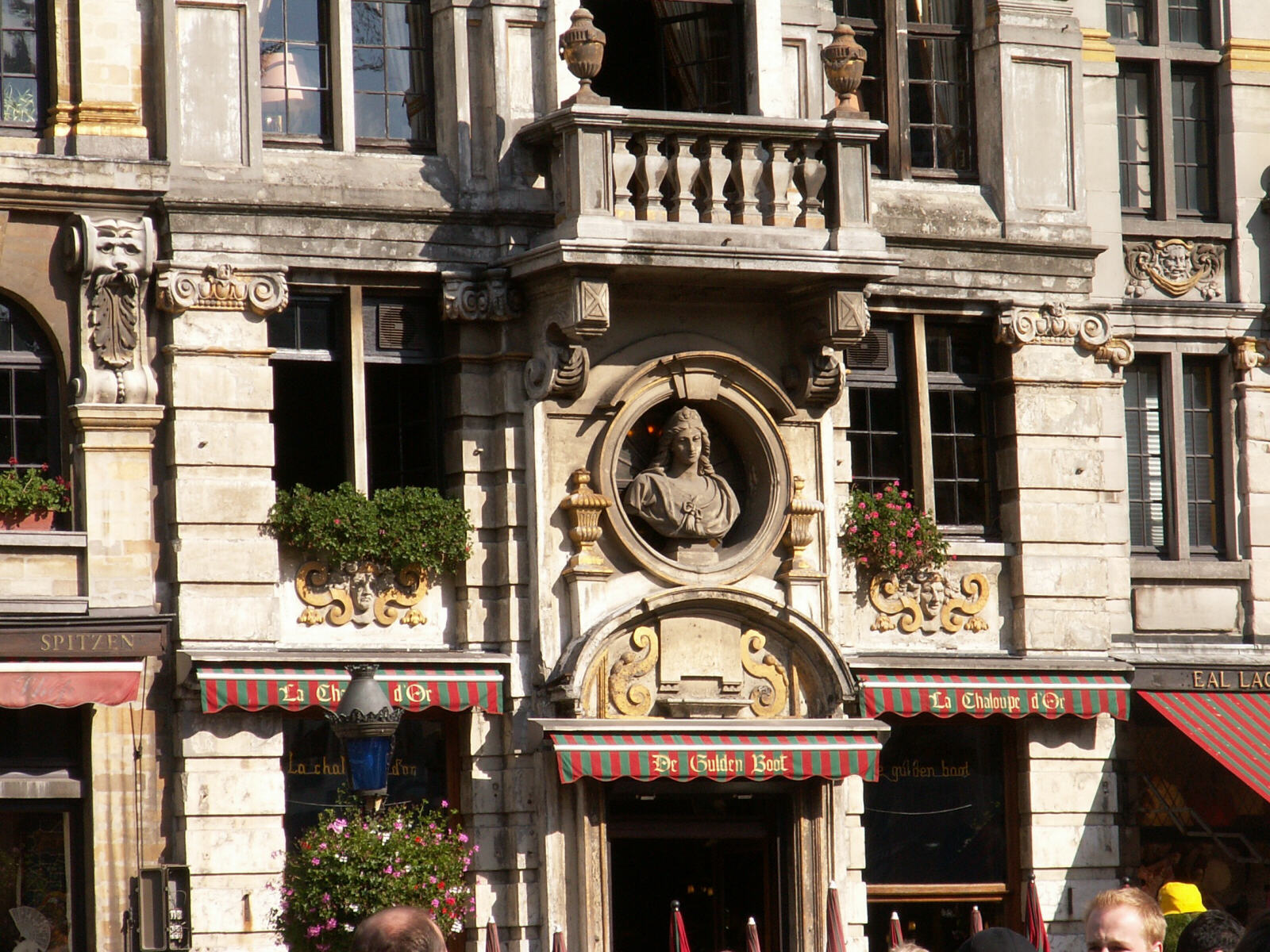
|
We bought a few essentials for the journey and a few non-essentials like passionfruit sorbet at the Australian ice cream shop. Our onward ticket also covered the local train from Brussels Central to Midi, where we found the train to Minsk. It was a Russian train with slightly less than welcoming staff and, as we found out too late to buy any food, no restaurant car. However, our two-berth sleeping compartment was really cosy and we settled in for a comfortable night rolling across Germany. At about 2am the Polish border guards woke us up to have a quick look at our passports but we were on our way again in a few minutes.
Sun 2nd. We woke to an overcast but bright day in Poland. We thought there might be some food for sale on the platform of Warsaw station where we stopped and waited for some time, but the station seemed empty and deserted. When we got to the border with Belarus we went through a more lengthy passport check, then we were shunted into a shed to have the wheels on the carriages changed because the Russian rail system uses a wider gauge than other European ones. This took a couple of hours but it was fascinating as we were hoisted into the air, carriage, passengers and all, and left dangling there while they swapped over the bogies underneath. |
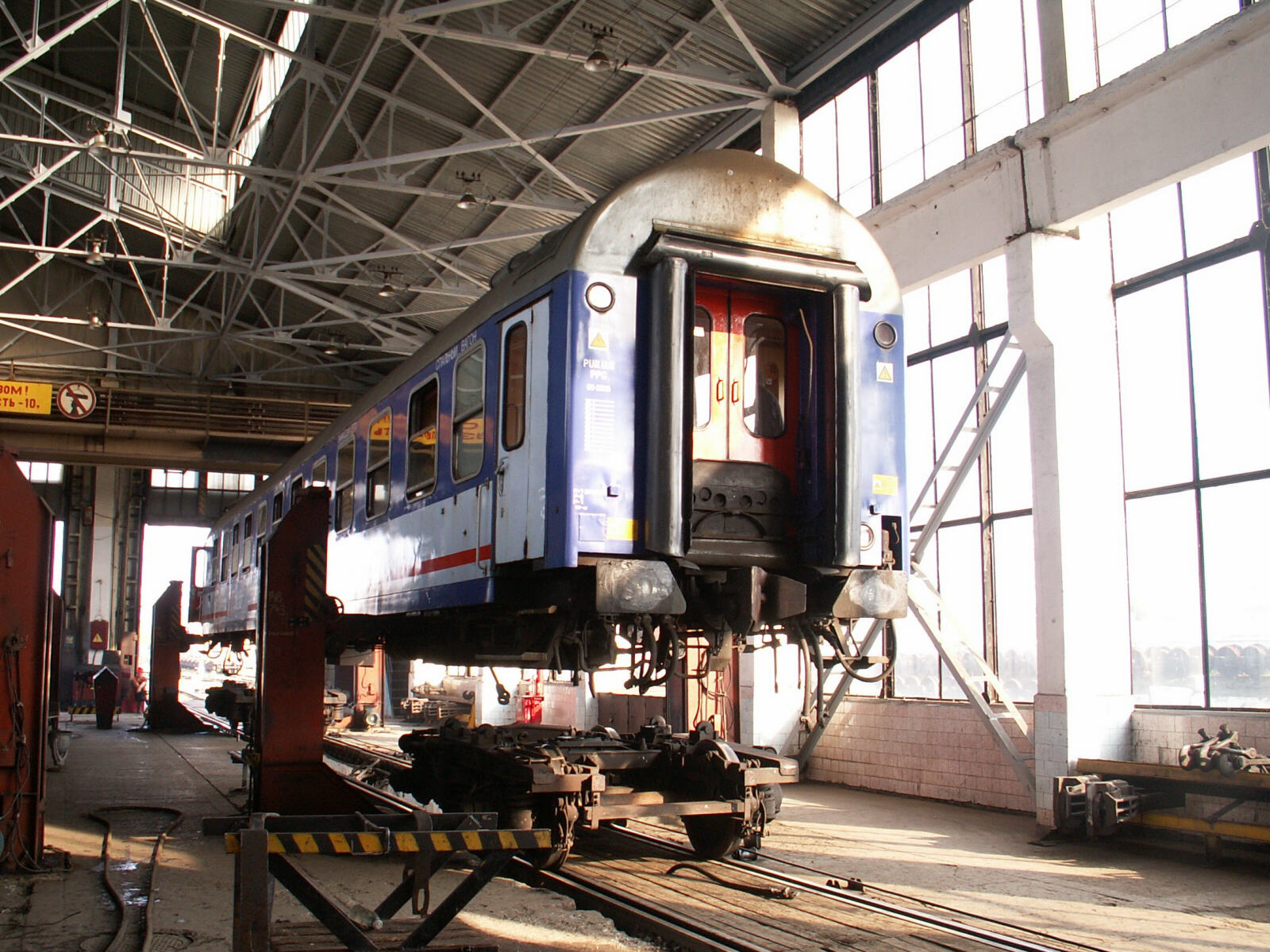
|
Minsk, Belarus
|
They added a restaurant car after the border so as we trundled through the flat Belarus countryside we had a very nice evening meal of chicken, sausages, blinis and salad. We arrived at the palatial railway station in Minsk and caught an old, rattly taxi which just made it to our hotel, the Yubleinaya, which was surprisingly nice with solid, old-fashioned furniture and a view towards the city centre.
Mon 3rd. After a leisurely and very good breakfast at the hotel we set out to explore Minsk. We wanted to go to the Dudutki museum of old farm buildings so we got a trolleybus to the centre of town and went to the travel agent 'Vokrug Sveta' where Marina, the very helpful manager who spoke excellent English, told us it was closed on Mondays! We therefore reverted to plan B and walked round the city for a while, passing what is reputedly the KGB building in Kamsamolskaja street along the way. |
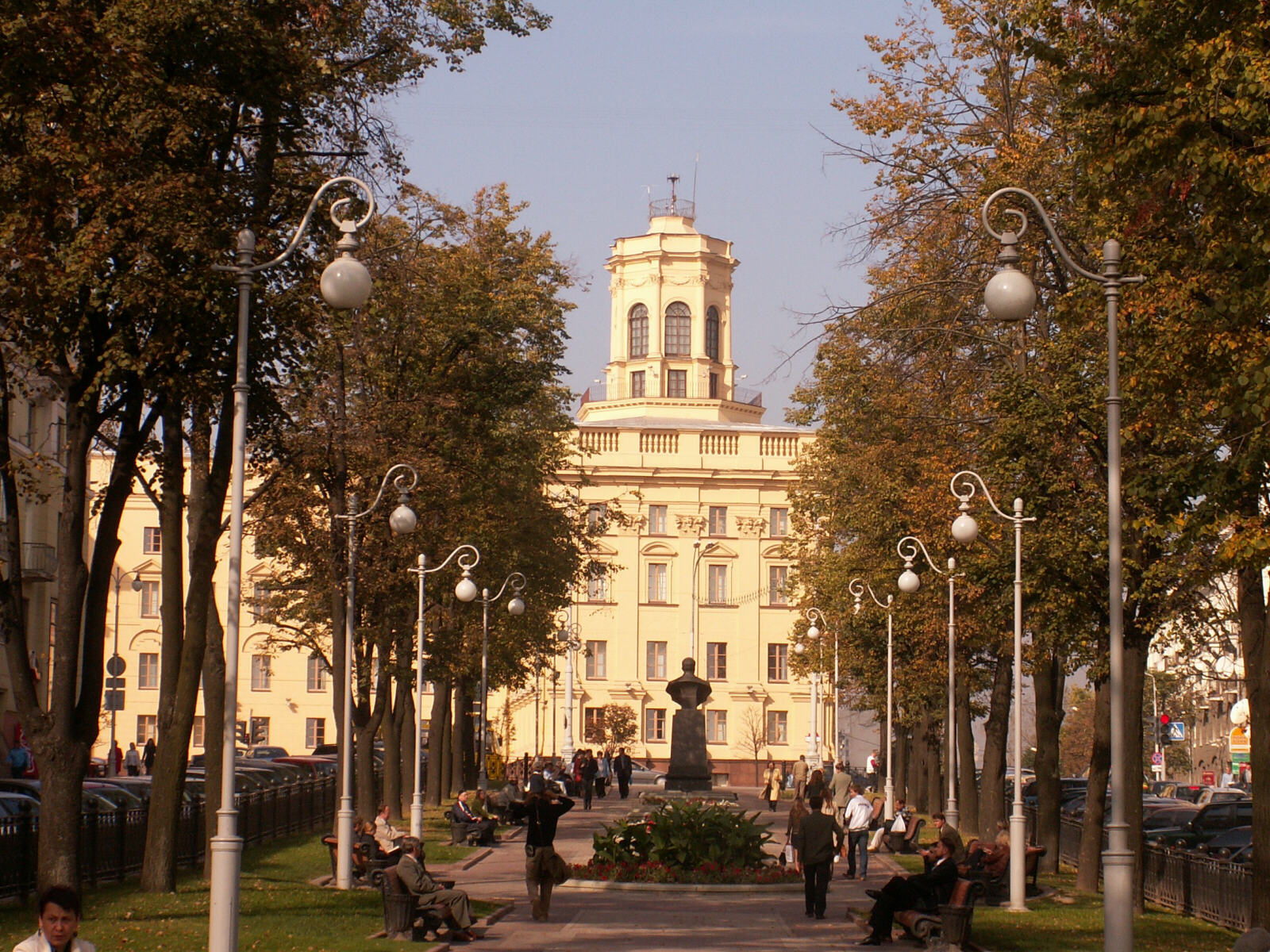
|
Then we got a number 100 bus which runs along Francyska Skaryny Prospekt, the main street across the city, up to the University at one end then down to the airport at the other. That was a very good city tour for 20 pence each, so we went and had a slap-up lunch with copious dark beer at the 'Rakovsky Brewery', a micro-brewery and restaurant near Saints Peter and Paul church in what had once been the centre of the old town. |
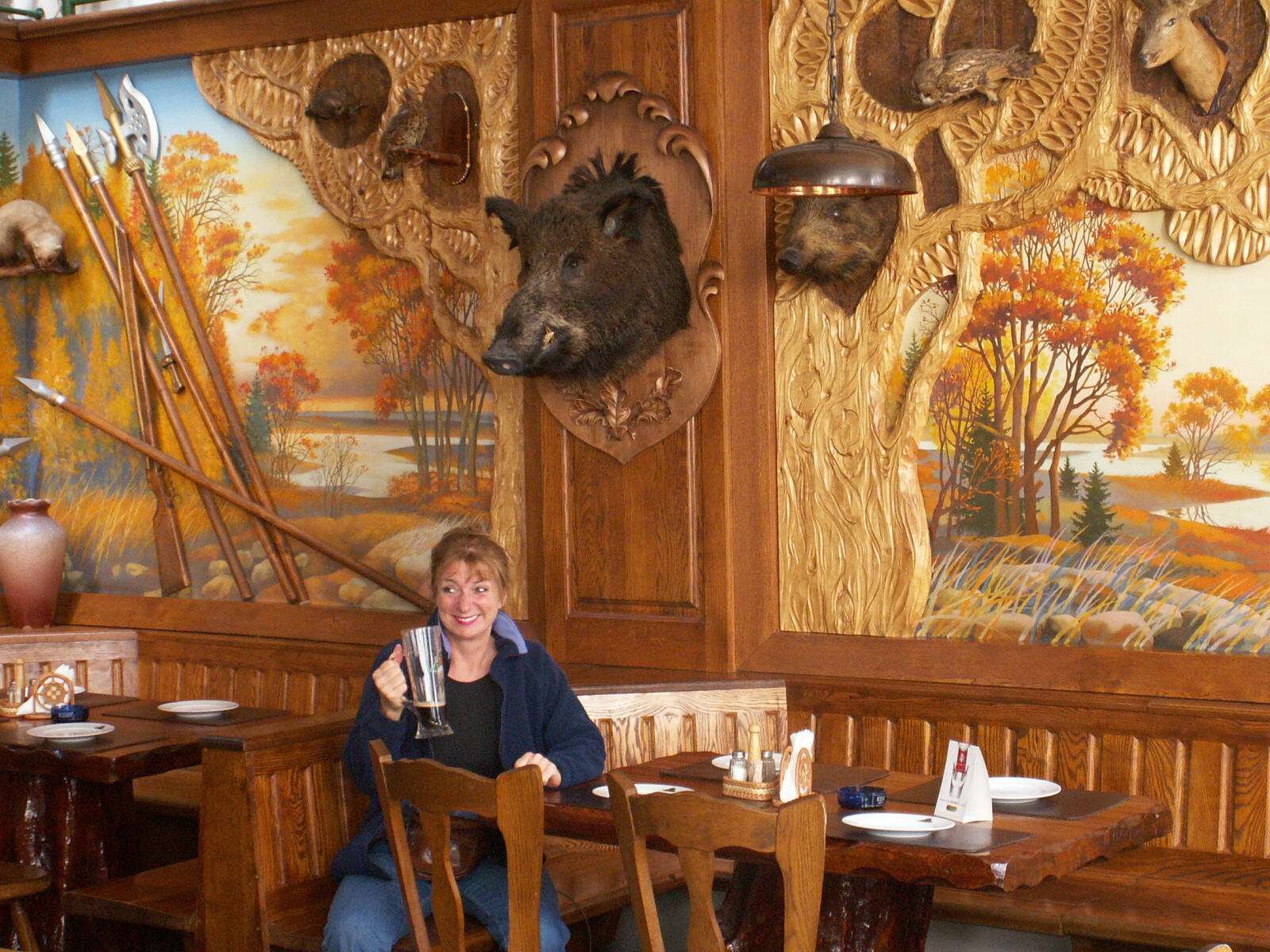
|
While Sheila slept off the effects of the dark beer I had a pleasant walk along by the river to St Dukhawski Cathedral. |
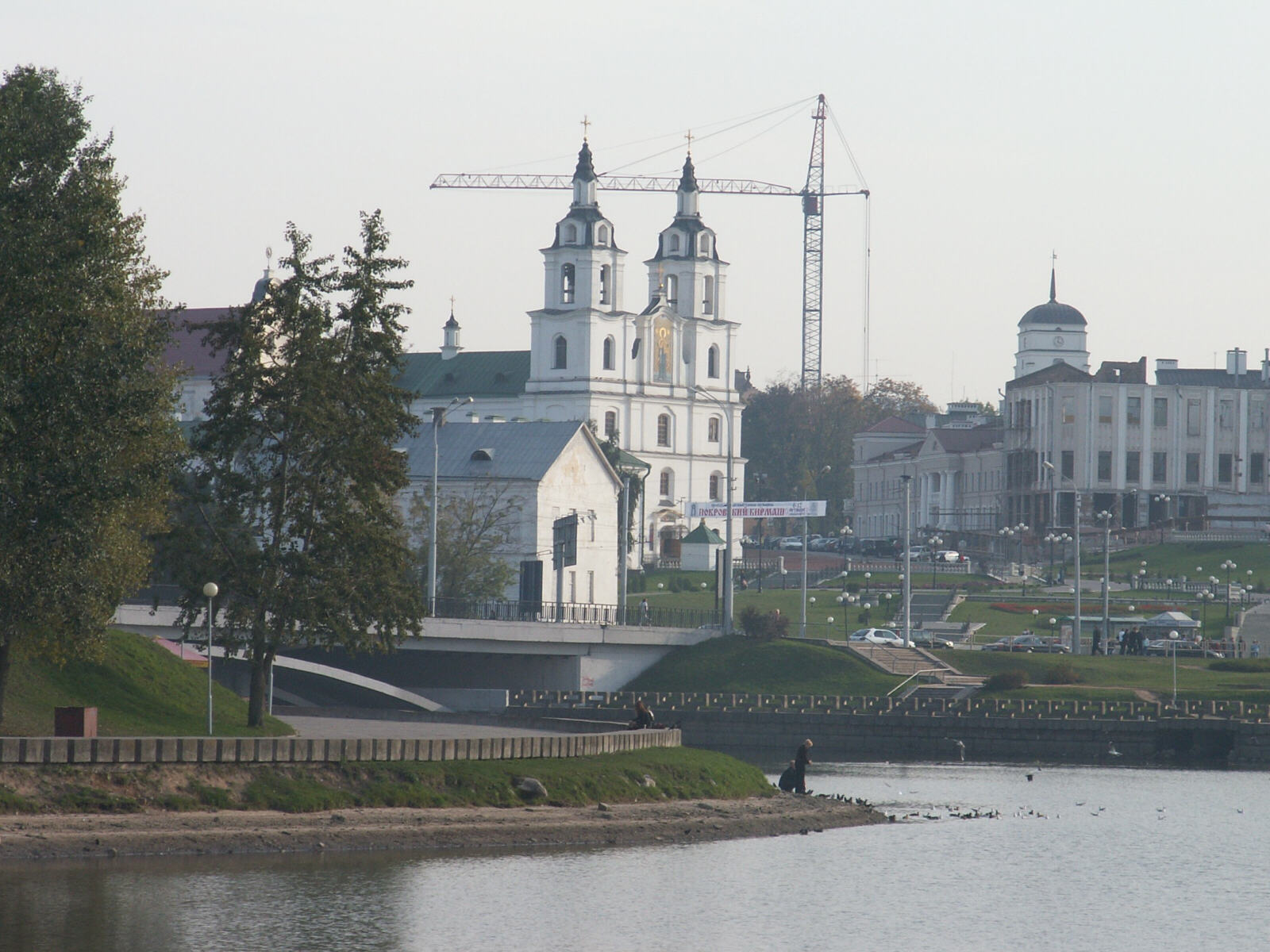
|
Then I completed the set by going for a ride on the metro (subway) for 10 pence. For an evening meal we had fish soup and another dark beer while musicians serenaded us and inebriated Belarusians danced around the tables.
Tues 4th. Breakfast at Hotel Yubleinaya did not start until 7:30 so we had a rushed meal while they were still setting it out, then dashed off to the railway station to catch the 8:20 train to Moscow. We whiled away the 12-hour journey reading and trying to understand the nice Russian couple who shared our carriage and tried to talk to us in Russian. We gathered that they were on their way for a holiday on the Black Sea. |
Moscow, Russia
|
Strangely there were no border formalities at all as the train entered Russia and we arrived in Moscow without anyone as much as glancing at our passports. This could be a problem when we come to leave Russia - we will see. After a bit of haggling with a couple of dour Russian taxi drivers we paid too much to go to the enormous Hotel Ukraina, where we queued for some time while the receptionists talked to each other and ignored the guests. Some things haven't changed since we were in Moscow 20 years ago, although outside it's amazingly different - the streets are full of casinos, bright lights and traffic chaos. After checking in we were recommended to go to Pushkinskaya Square where there are several bars and restaurants, and we had a wonderful and most unexpected Mongolian Barbecue at 'Traktir', although you are only allowed one plateful, unlike other Mongolian Barbecue buffets.
Weds 5th. We left our luggage at the hotel and set out to see the Kremlin. We got a trolleybus down the main road outside the hotel to the city centre and then queued for ages to buy a ticket, or rather two tickets, into the Kremlin, one for 'Cathedral Square' and the other a timed ticket to the Armoury Museum. This cost 350 + 300 roubles each + 50 roubles for the camera (about £28 altogether for two of us). The whole place was very impressive with the sun glinting off the golden domes and the inside of each of the cathedrals full of icons and paintings. |
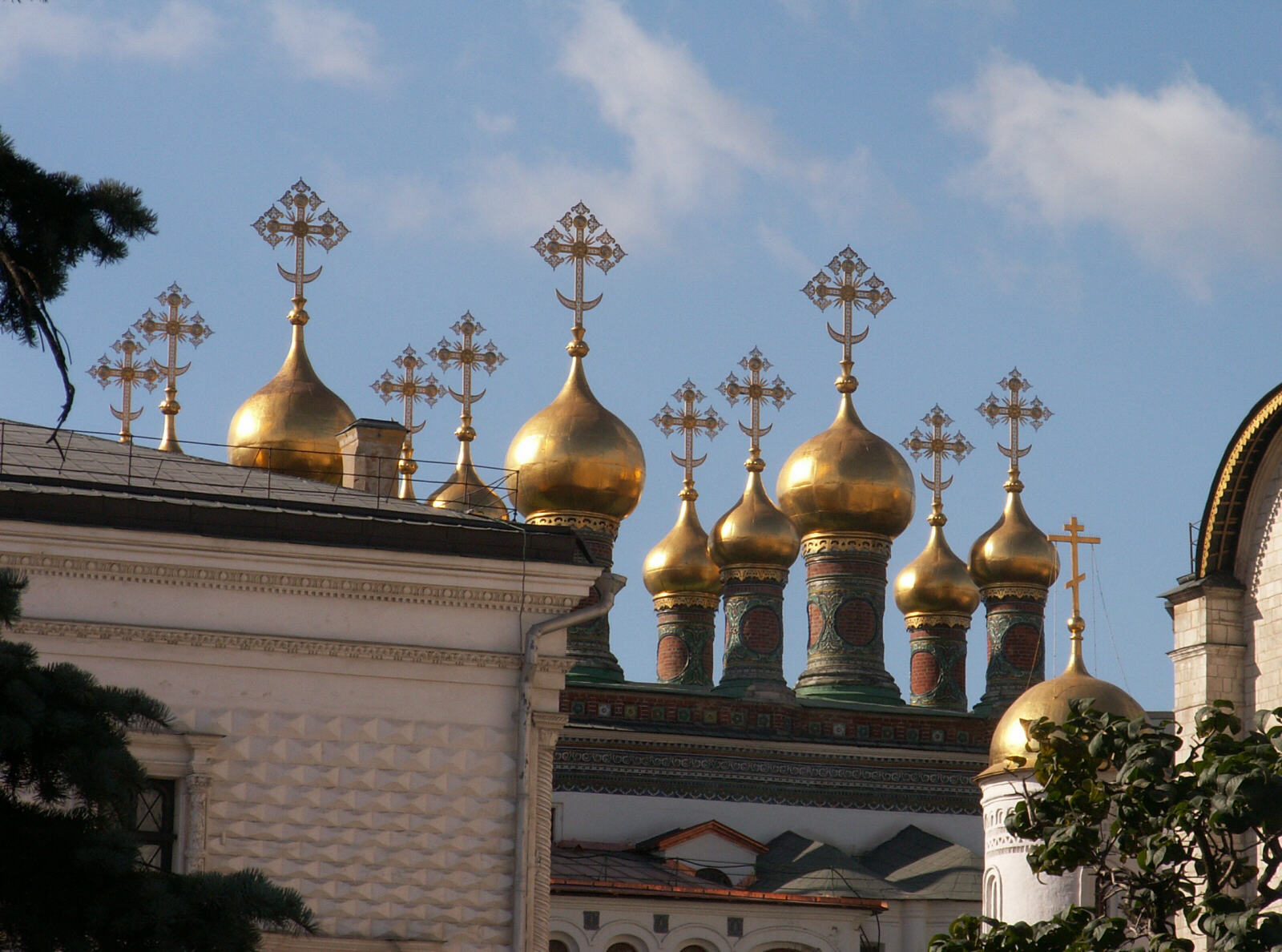
|
The Armoury Museum was wonderful, full of gifts to the Tzars ranging from ornate carriages to incredibly elaborate Fabergé eggs, one of which contained a golden sailing ship and another a complete working model trans-Siberian train. Sheila also paid an extra 350 roubles to see the 'Diamond Fund', a separate room containing the Russian 'crown jewels' which she said were amazing. |
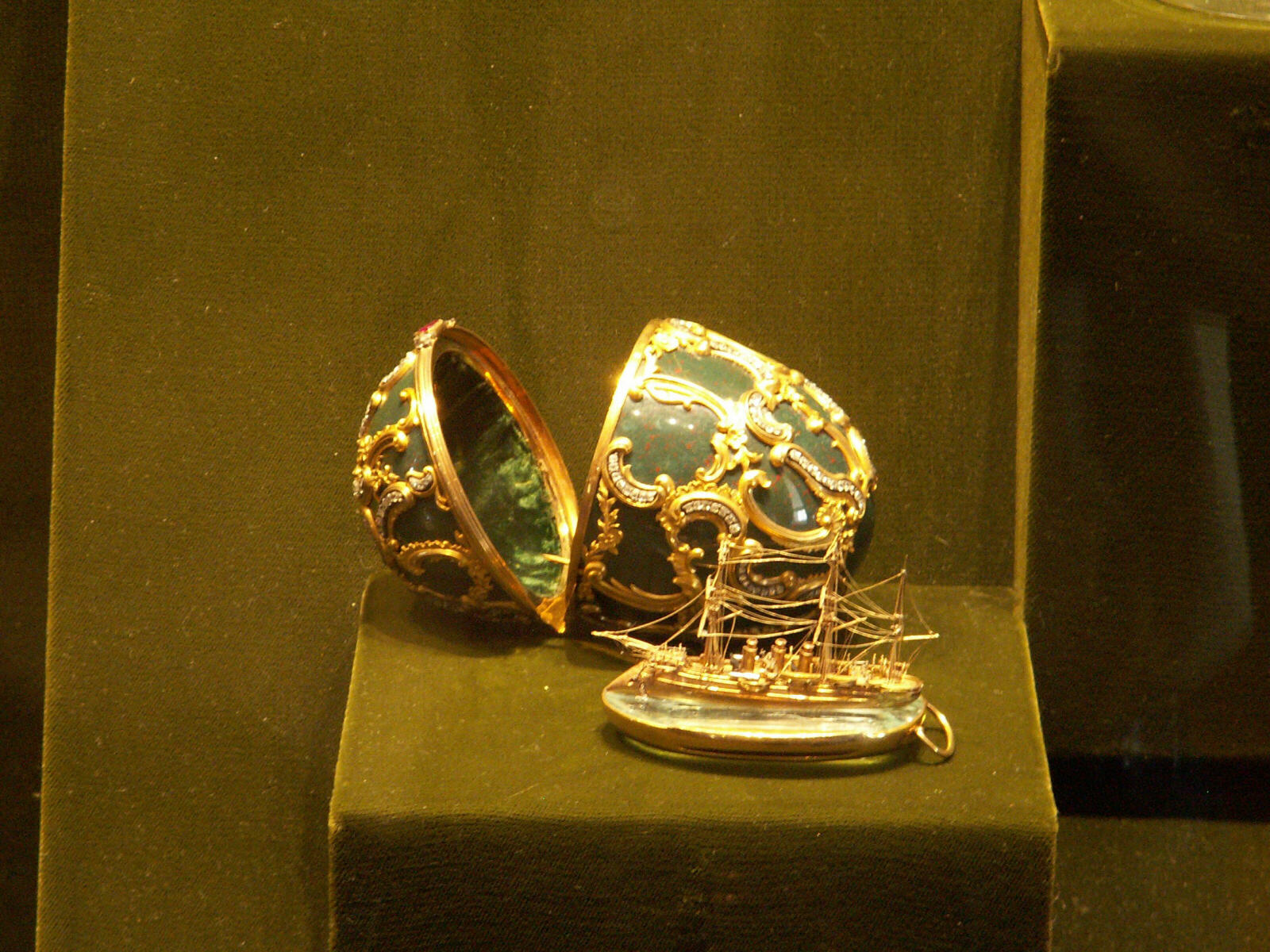
|
Outside the Kremlin we walked once round Red Square, where St Basil's Cathedral was as wildly ornate as ever but GUM department store couldn't have been more different than the last time we saw it 20 years ago - gone were the near-empty shelves with a few cheap clothes and loaves of bread, in were the latest designer fashions from France and Italy. |

|
We walked up Tverskaya Street to Pushkinskaya Square and had another Mongolian Barbecue for lunch/dinner. Then we tried to get the metro back to Hotel Ukraina, but we went wrong and ended up walking for miles back to the hotel, which made us late and we raced across Moscow in a taxi through the rush-hour jams in a panic to Yaraslavski Station. Luckily we arrived in time to catch our train, the 9:20pm 'Rossia' trans-Siberian bound for Vladivostok. Our compartment was extremely cosy, with two beds side by side (not stacked one above the other) complete with wall mirrors and a TV set! |
Part 2 - our route across Siberia, stopping in Irkutsk and visiting Lake Baikal.
|
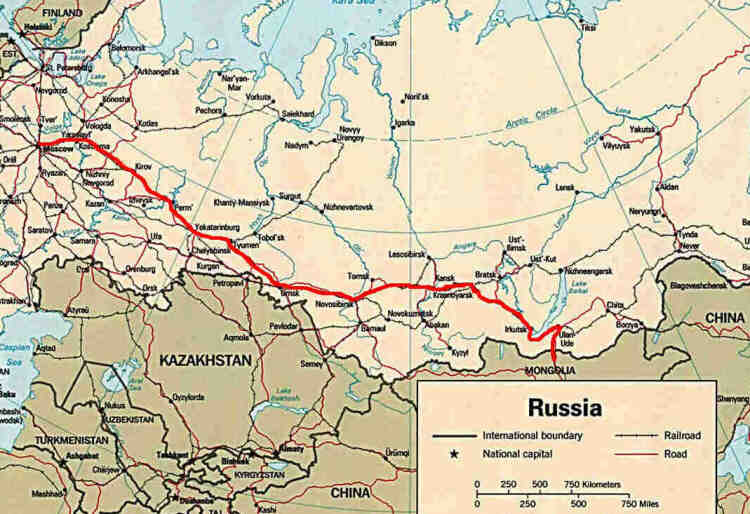
|
Our train tickets on the trans-Siberian railway to Irkutsk and on through Mongolia to Datong in China.
|
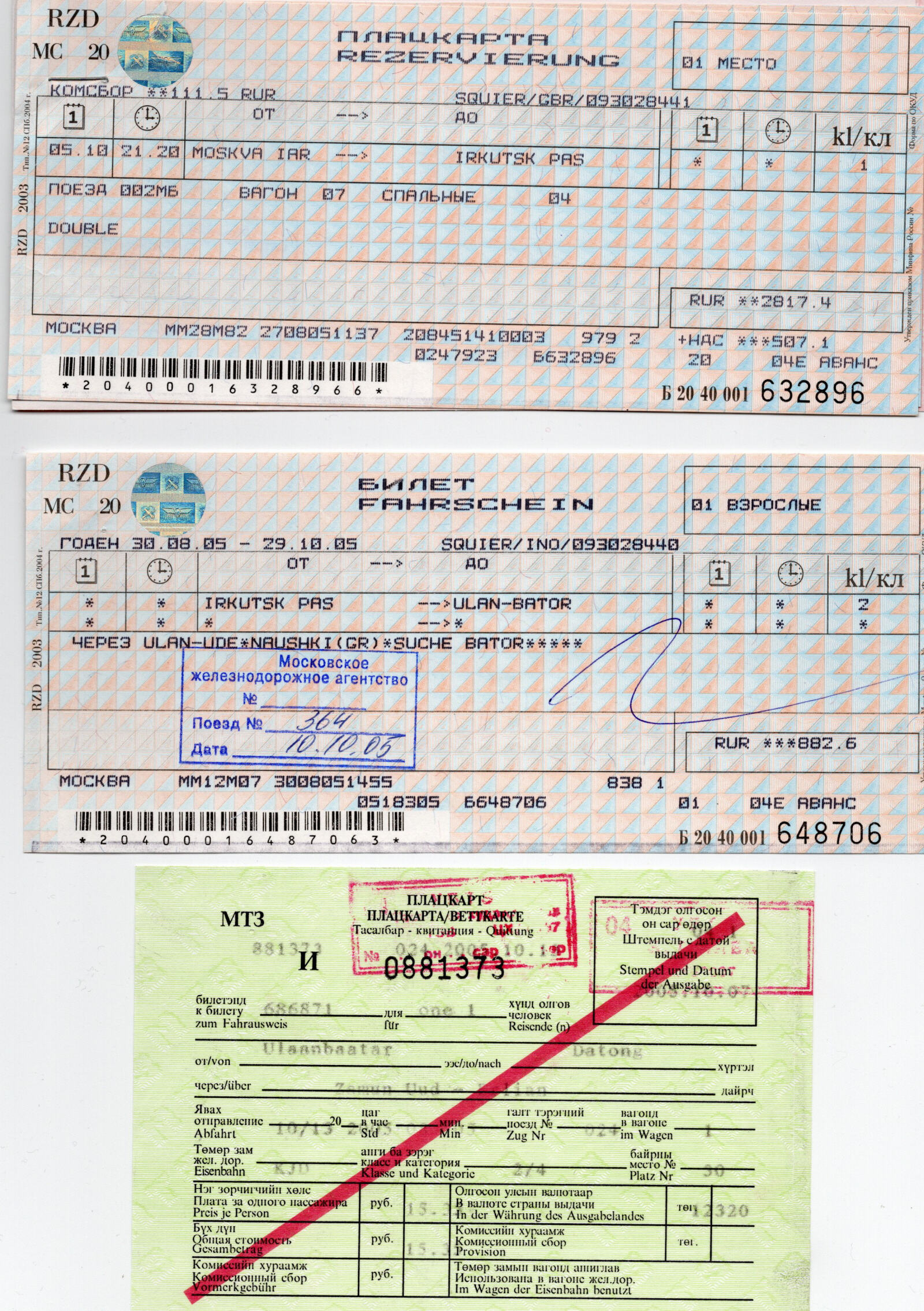
|
On the 'Rossia' trans-Siberian train
|
Thurs 6th to Sat 8th Oct. By the time we reluctantly crawled out of our cosy beds, nearly a thousand kilometres had rolled by and it was 9am in train time or 10am local time wherever we are (the train and railway stations always keep Moscow time, even eight time zones away in Vladivostok). For breakfast we had some ham and cheese sandwiches and tea with boiling water from the always-on samovar at the end of the carriage. After reading and dozing for a while we went and had a beer and some smoked salmon on bread in the restaurant car for a late lunch, but then we passed into another time zone so it was after 5pm and so we had some more beer and chicken, chips and salad for dinner. It was a hard life on the Trans-Siberian train. |
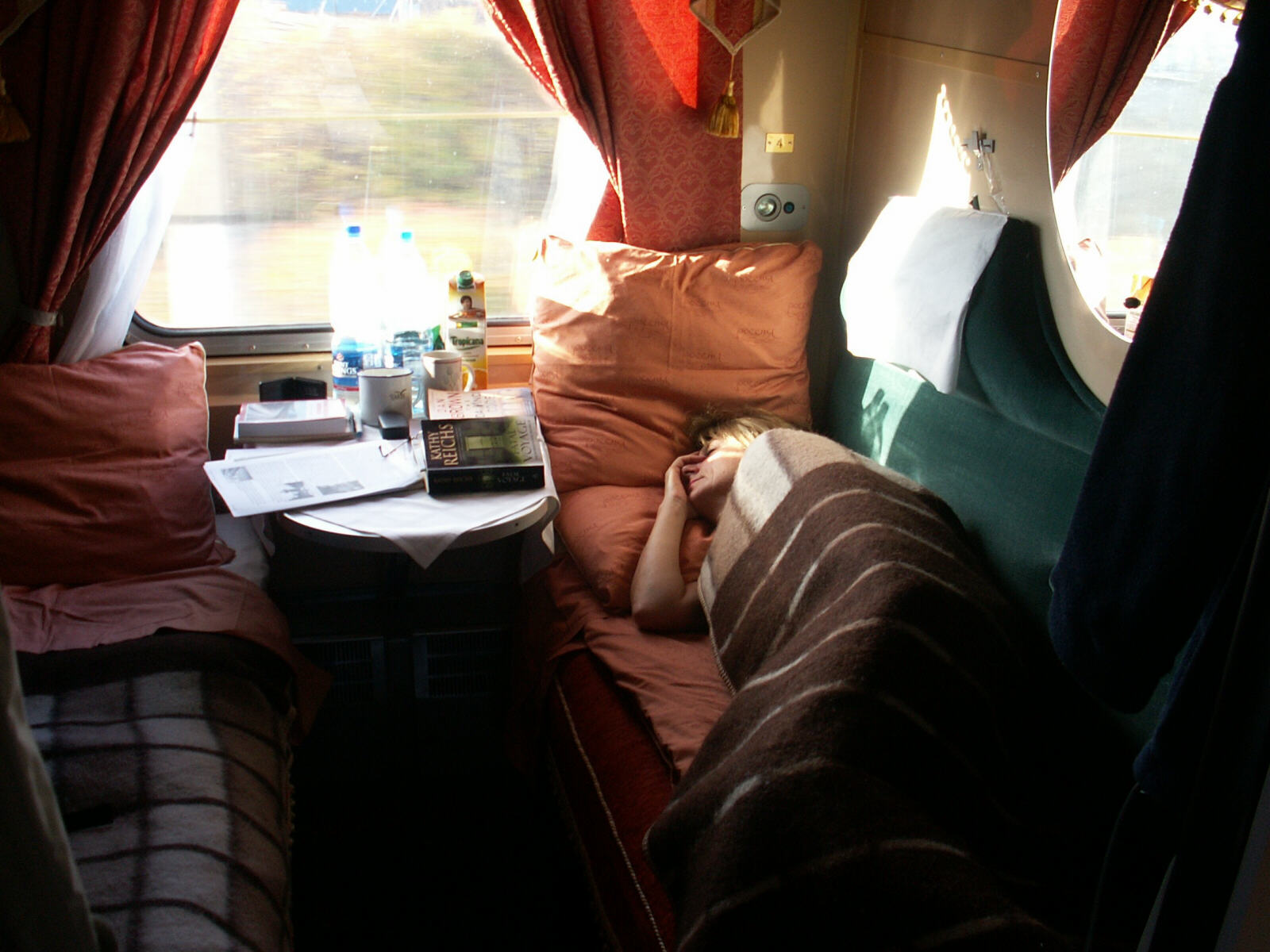
|
On Friday we woke up in Siberia, having crossed over the Ural mountains and later passed the administrative boundary of Siberia in the night. After another breakfast of sandwiches we had a stroll around the station at Omsk where the weather was warm and spring-like, not at all Siberian, and Sheila filmed the event for posterity. |
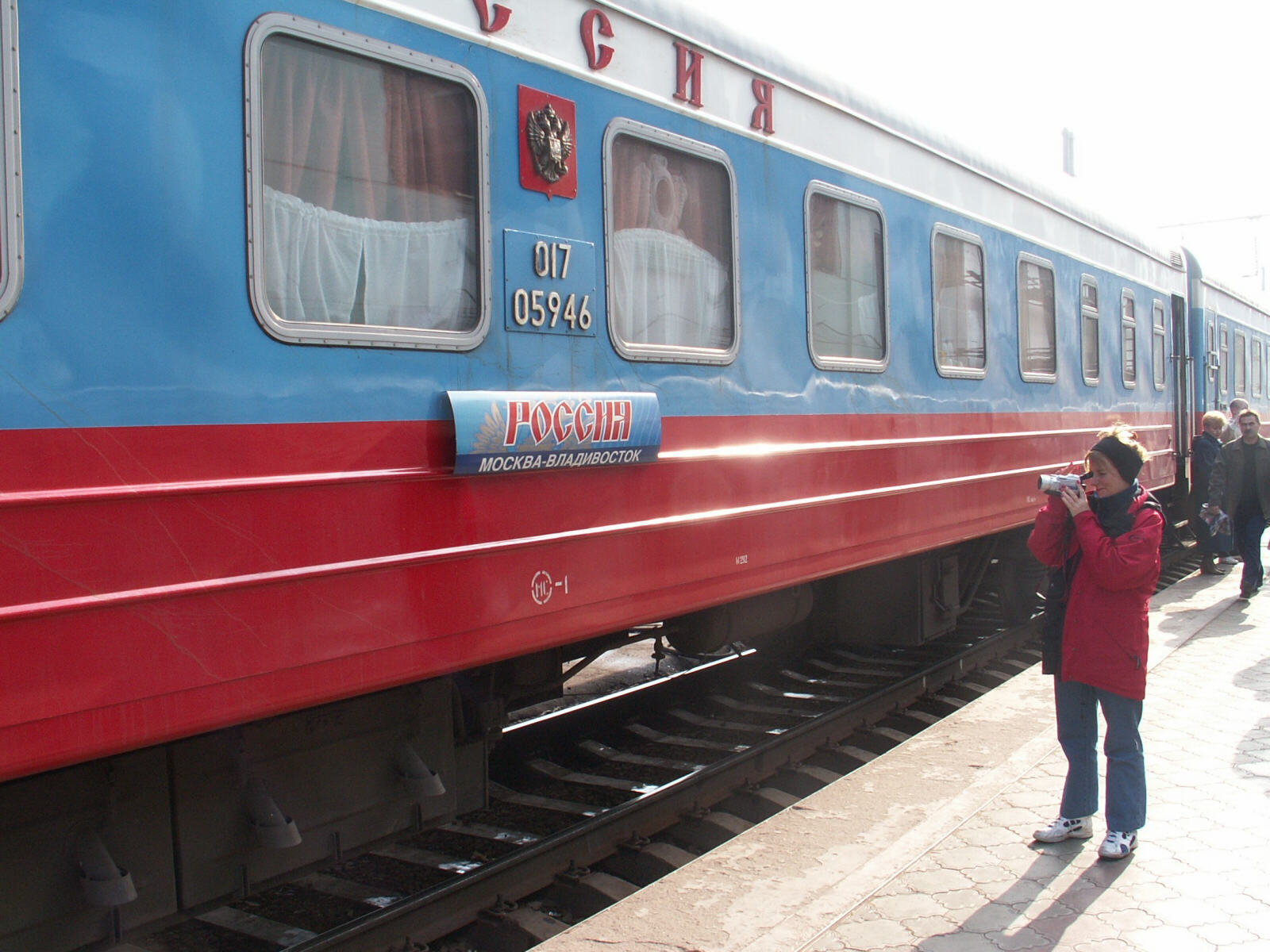
|
For lunch we opened a bottle of Russian 'champagne' that we had bought at a small shop in Moscow, but the occasion was dampened by the fact that the constant shaking of the train made the 'champagne' rather explosive and it ended up spraying all over the compartment. Nevertheless, we had a pleasant celebration of our arrival in Siberia with champagne, orange juice and peanuts. The faint smell of alcohol haunted us for the rest of the day, helping to mask the occasional whiff of toilets from down the corridor. Again we read and dozed through the afternoon as mile after mile of flat grassland with clumps of birch trees flashed past the window. The occasional wooden cabin seemed to be a long way from anywhere.
|
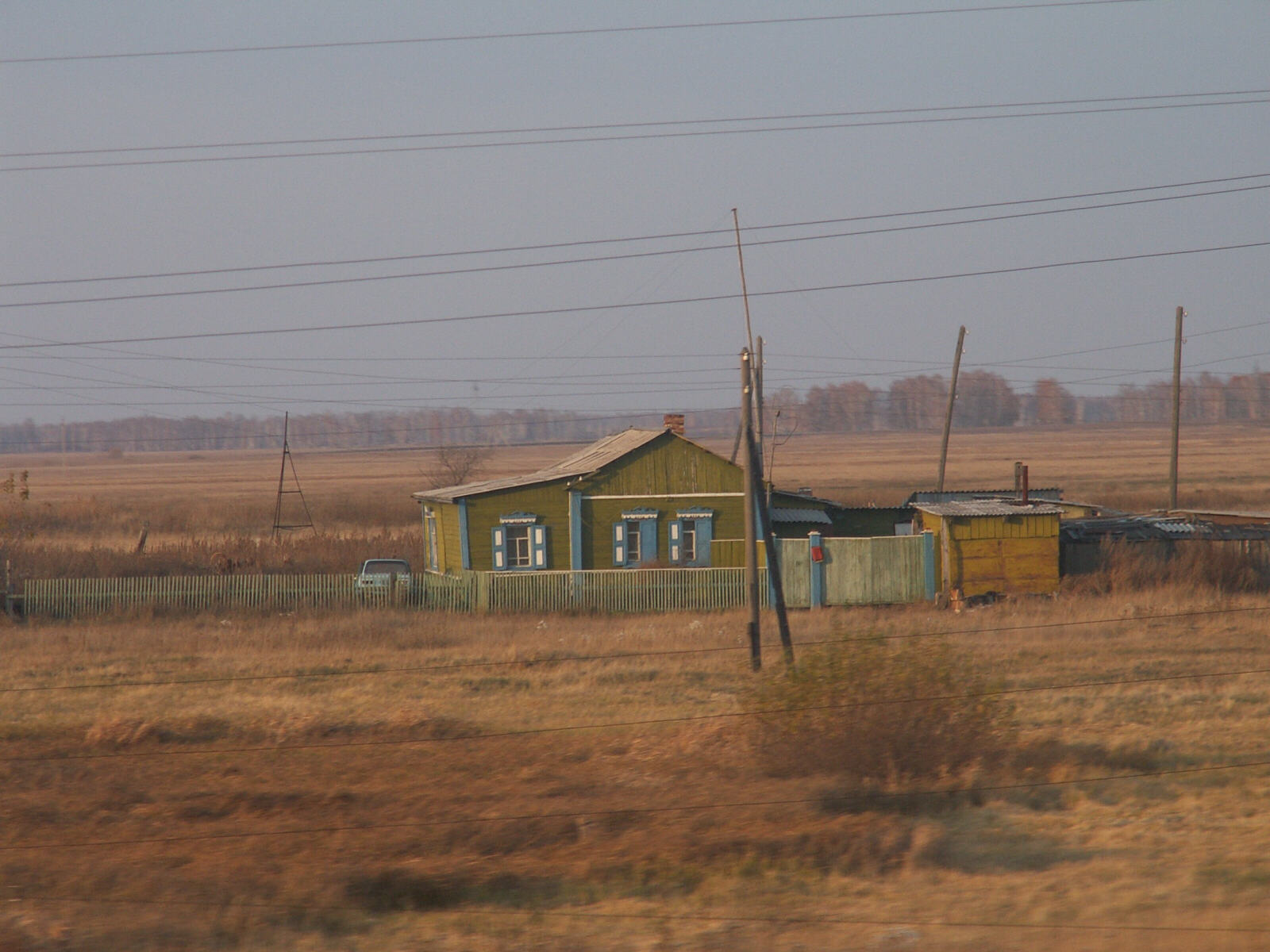
|
A settlement in Siberia, around kilometre 4016 from Moscow.
|
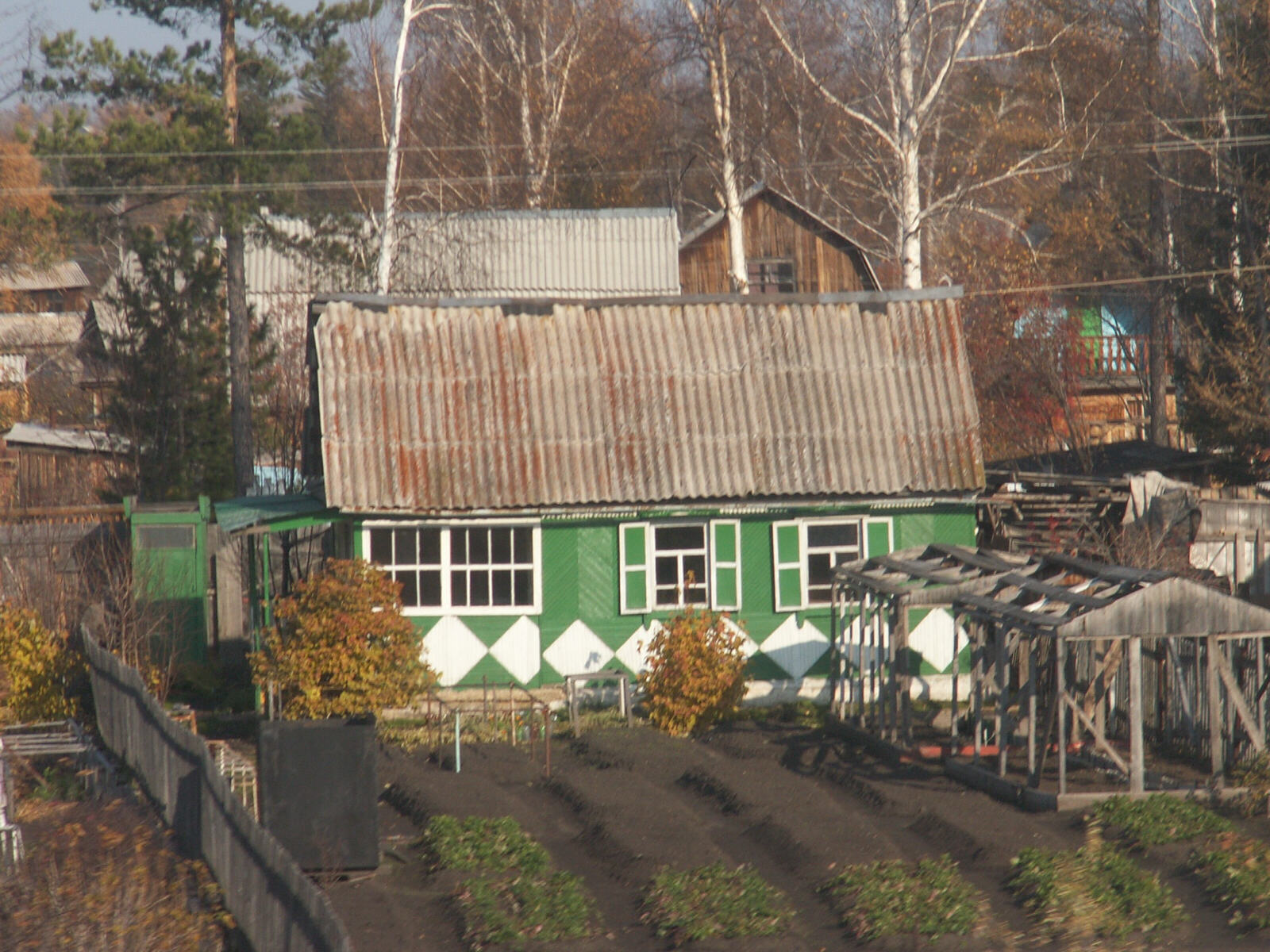
|
At each of the occasional stops the wheel-tappers came along playing out-of-key tunes on the train wheels. At dinner time the European expatriate community gathered in the dining car to choose between chicken, fish, pork or beef - the beefsteak with egg, chips and salad was very good. Saturday was another pleasant day of reading, dozing and eating. We had breakfast of fried eggs and salami on bread in the restaurant car and watched the pretty log cabins pass by in the Siberian forests. The absolutely flat land of the last two days had now been replaced by gently rolling hills. We bought two plates of smoked salmon and bread from the dining car back to our compartment and had our other bottle of Russian champagne with orange juice for lunch, then soup and beef for dinner in the restaurant car. |
Irkutsk and Lake Baikal, Siberia
|
Sun 9th and Mon 10th Oct. We arrived on time at Irkutsk railway station at 7:30am and were promptly met by Victor, a man holding our name-card, who whisked us away to our 'home-stay', which was a clean, bright and airy apartment at the top of a rather grubby block near the centre of town. Unfortunately it was a bit too early for the lady of the house who had obviously been woken by us ringing the doorbell, and we sat and waited in a sort of spare room while she booted her son out of our bedroom and prepared herself for the day.
After a walk round Irkutsk town we went on a tour with Victor and a driver to Lake Baikal, stopping on the way at the Museum of Wooden Buildings which was fascinating, with farmsteads, churches and a fort built by the early Russian settlers, as well as 'yurts' or temporary houses of the local Buryat people. |
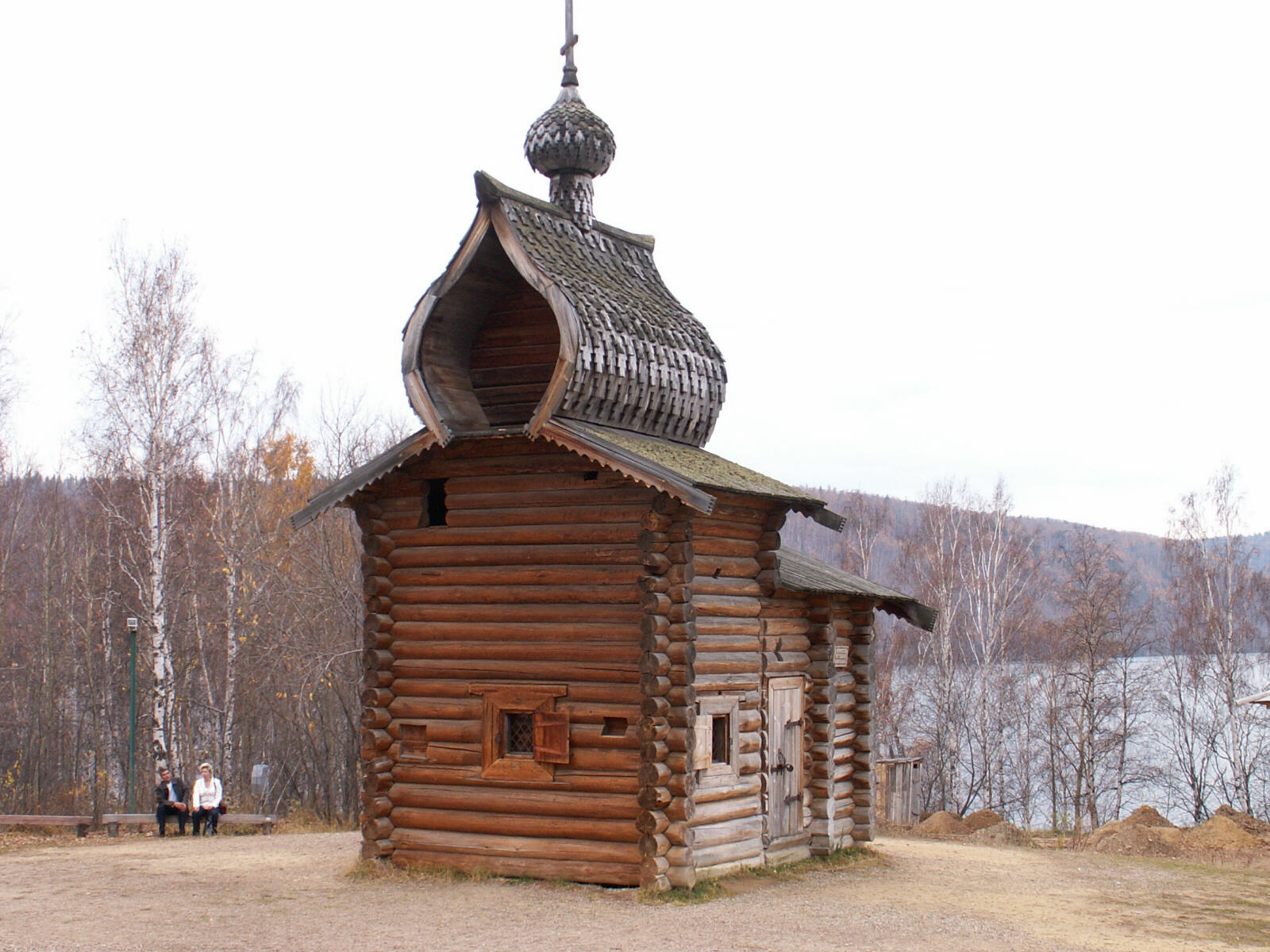
|
When we reached the lake there was an amphibious microlight aircraft parked on the shore so Sheila had to go for a noisy, jerky flight (as a passenger, not the pilot). The landing was a bit hair-raising, she said, plus the fact that the pilot did a few interesting manoeuvres to see if she would scream - which she did but with pleasure not fright. After this we went to Listvyanka, the fishing village on the lake where there was a smoked fish market in progress, where rows of ladies with 'smokers' were selling their fish and the air was filled with smoke and the smell of fish. The lake is there somewhere, behind the smoke. |
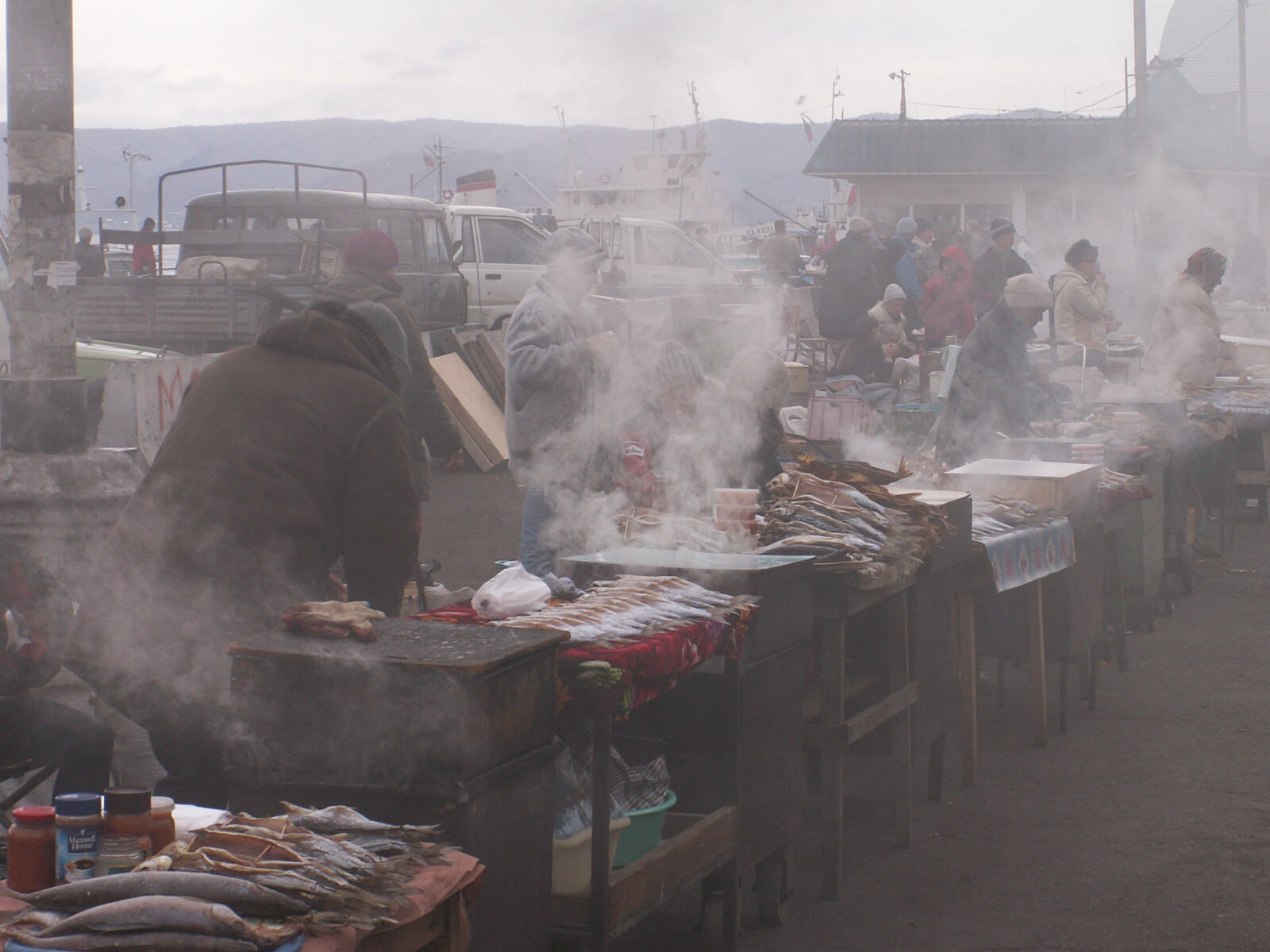
|
Lake Baikal itself was huge and very picturesque, but unfortunately it was then blotted out by a heavy shower of rain so we retired to a nearby restaurant for a lunch of Omul, the local lake fish, and caviar and sour cream on potato blinis. Returning to Irkutsk we had a bit of a walk round and then found the German beer keller that Victor had recommended and had some lovely Czech beer and a huge plate of mixed Bavarian sausages, which we later found out should have been for four people!
The next morning, after a nice breakfast of eggs and sausage at the homestay we set out for a walking tour of Irkutsk, but we didn't get very far before Sheila found a nail salon and booked a session later to have her fingernails done. We went to a huge shopping centre where again the focus was on fingernails and Sheila bought various polishes and polishers to embellish them. Nearby was the main market with wonderful meat, fish and cheese stalls and a fruit and vegetable market outside. Along the way we passed some pretty traditional wooden houses. |
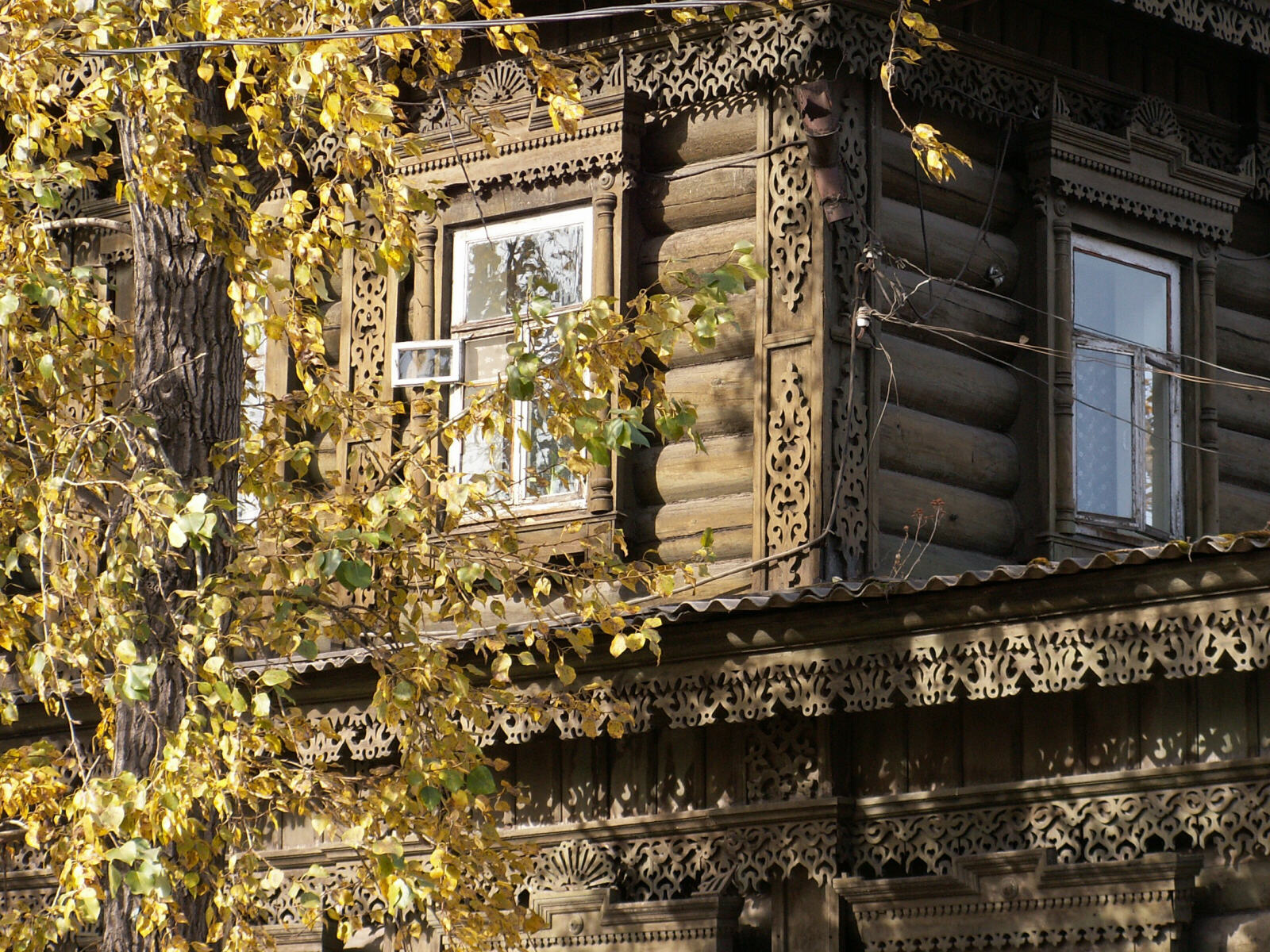
|
We went to visit the 'Decembrists Museum' in a wooden house which had been the home of Prince Trubetskoy who was exiled to Siberia from St Petersburg in the 1800s. His wife relinquished her hereditary title and most of her possessions to come to Siberia with him. Like many of the old wooden houses in Irkutsk it had thick log walls and beautiful detailed 'lacework' wooden designs round the windows and roof. We then had a route march across town to arrive late for Sheila's nail appointment, followed by another mad dash back to the beer keller for black beer, smoked salmon and sausages for dinner. The final race across town got us back to the homestay where the taxi had only been waiting ten minutes for us and took us to the railway station, where the train was late coming in so we needn't have rushed. We set off at 8:10pm and travelled along the most picturesque stretch of the trans-Siberian as it goes around Lake Baikal, but it was pitch dark so we couldn't see anything.
Tues 11th - crossing the border into Mongolia. After a gentle ride through south Siberia we arrived at the Russian border where we spent the next ten hours crossing into Mongolia. First we sat there for three hours while nothing happened, so we found a shop on the platform where we bought champagne, cheese, salami and bread which helped to pass the time, then for the next two hours various officials came and asked us to fill in forms or to look at our passports. It didn't seem to matter that we hadn't got a customs form or immigration stamp when we had missed Russian immigration coming from Minsk. At 6pm we finally got moving again, but not far - we then stopped at the Mongolian side and repeated the process in reverse: forms and passports followed by several hours of doing nothing. The rest of the train had gone and the single carriage full of Europeans sat in isolation in a siding while everybody drank champagne and vodka and gradually lapsed into drunken stupors, until we finally got going around 11pm. |
Part 3 - our route across Mongolia and China, stopping in Ulan Baatar, Datong, Beijing, the 'water towns' and Shanghai.
|
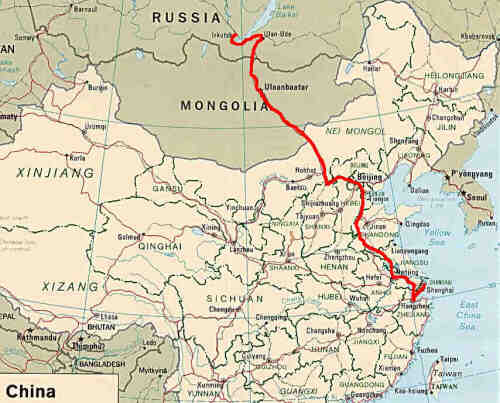
|
Our Chinese train tickets from Datong to Shanghai.
|
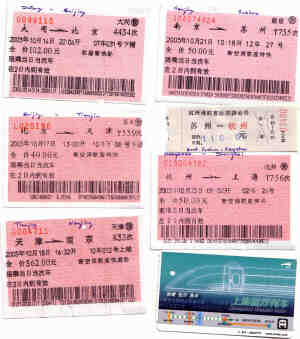
|
Ulan Baatar, Mongolia
|
Weds 12th. We arrived early at Ulan Baatar station and were whisked off to the Palace Hotel. As soon as we'd dropped off our things we set out to do the town. We got a taxi to the Gandan Monastery and entered through the impressive gateway .... |
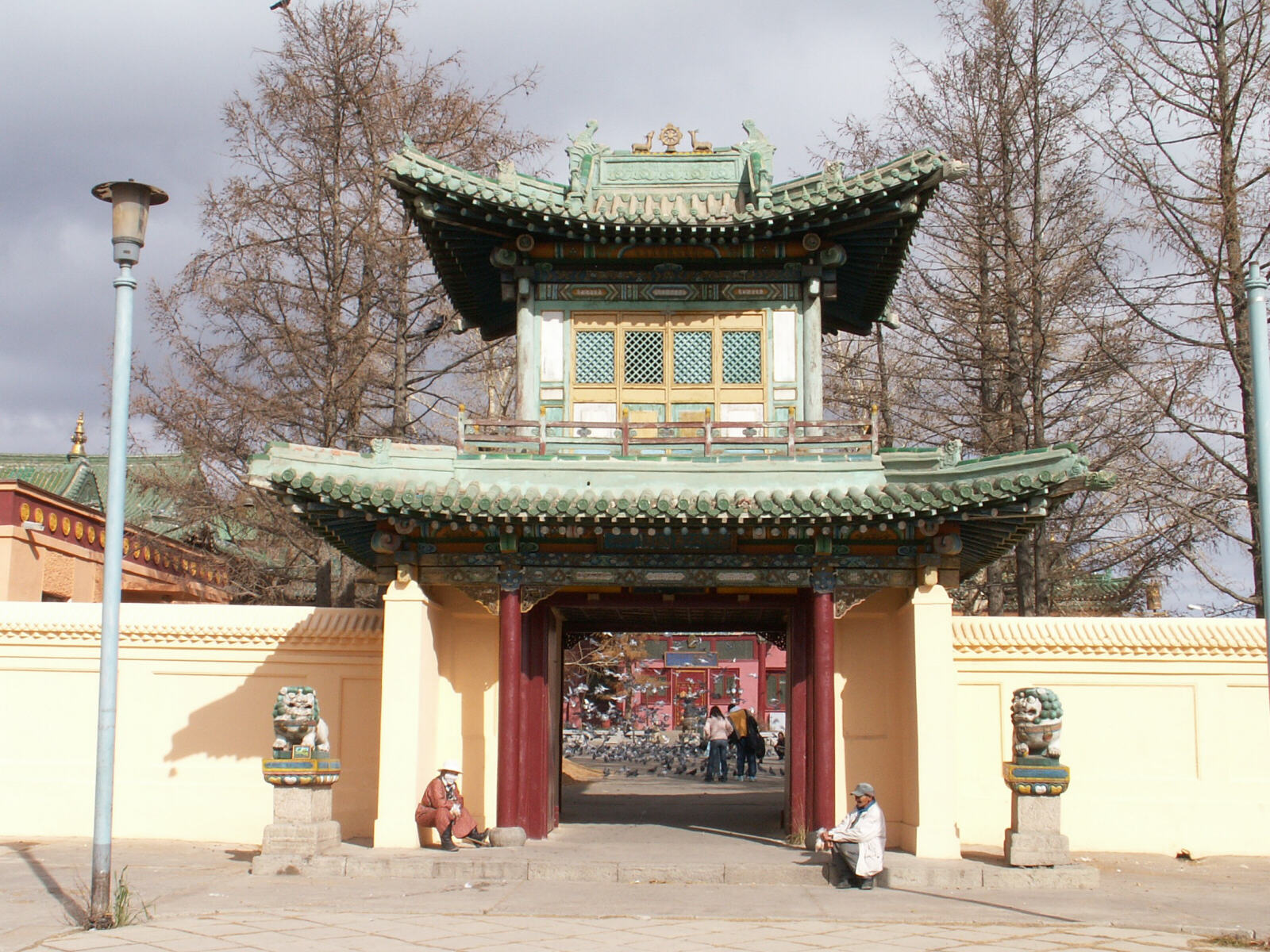
|
.... into the monastery complex where the morning service was starting, with Tibetan-style chanting and banging of cymbals, while in other buildings within the compound young monks were learning their tantras. There were all sorts of fascinating people walking about in the monastery and we stayed for some time watching the world go by. A monk was waiting for people to bless at the Vajradhara Temple in the Gandan Monastery ....
|
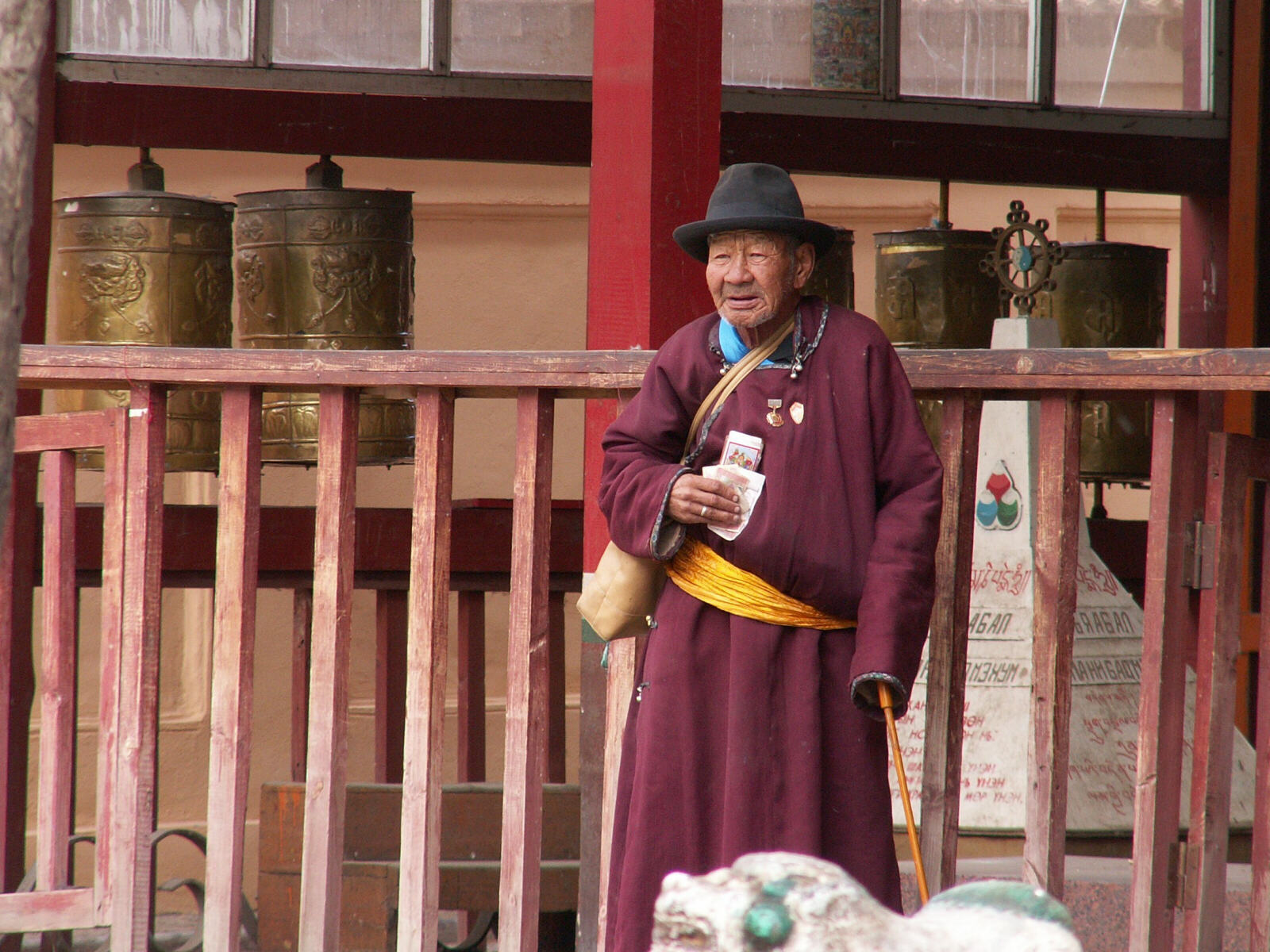
|
.... and he was enthusiastic when a customer arrived.
|
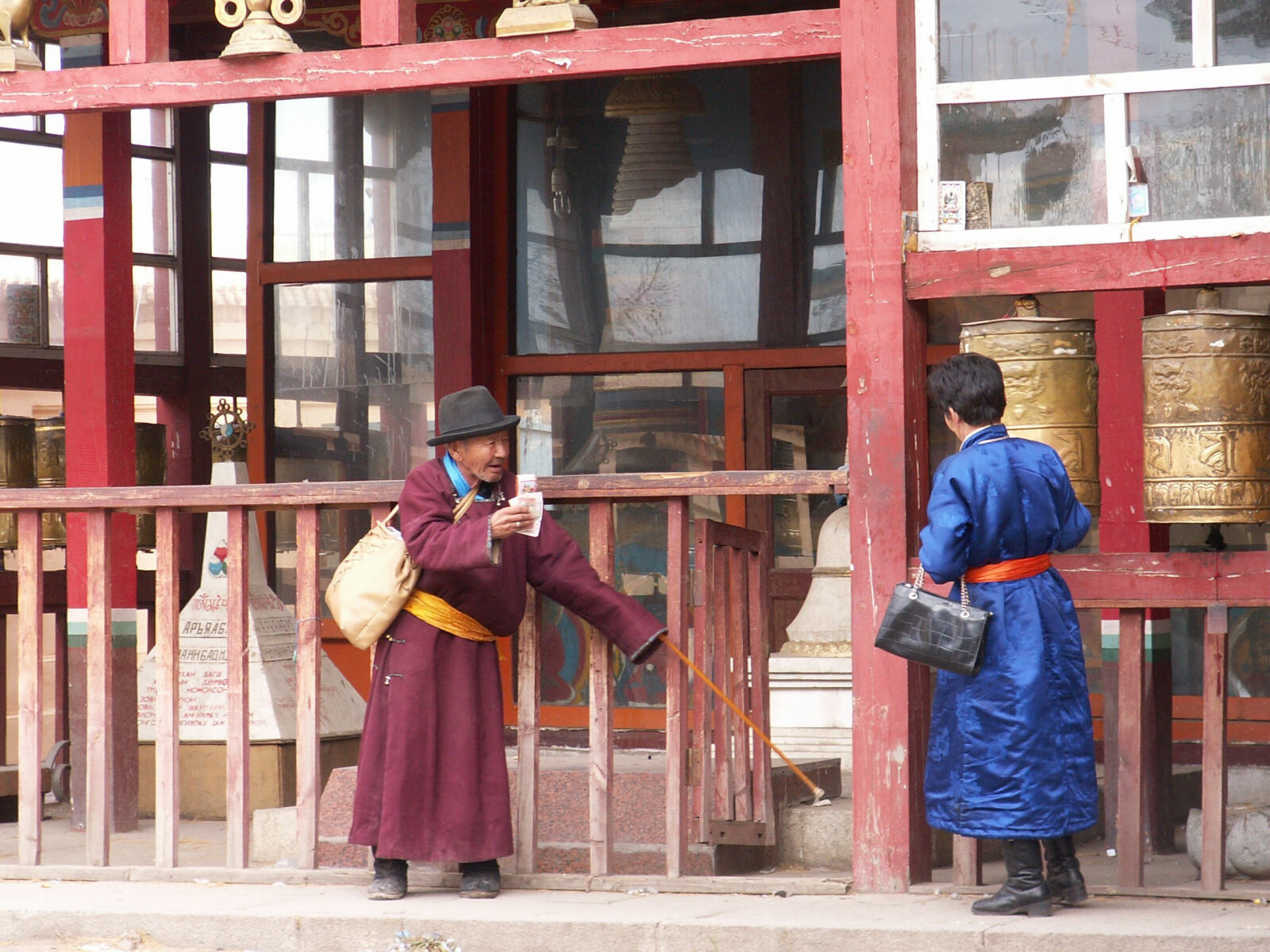
|
It was bitterly cold outside the buildings, with a freezing wind whistling down from the Siberian Arctic. Nearby was an encampment of 'Gers', the 'mobile homes' used by Mongolian nomads. We went inside one which was occupied by monks and was a sort of mini-monastery, then a little girl invited us into a nearby one and for 50 pence gave us a 'guided tour' of her circular, one-roomed home. Eventually we walked down to the city centre, stopping on the way at the government department store and a very nice café for cake and coffee, then at the post office to post some cards, which all arrived at their destinations surprisingly quickly.
From Suhbaatar Square, the bleak and windswept Soviet-style main square, we walked round by Choijin Monastery but didn't go in because it is a museum rather than a working monastery, then got a trolleybus back to the hotel which happens to be close to Bogd Khan's palace. Unfortunately the palace was closed today but we hung around outside the entrance gate and a nice security guard took us into the complex and showed us around the outside of all the buildings. |
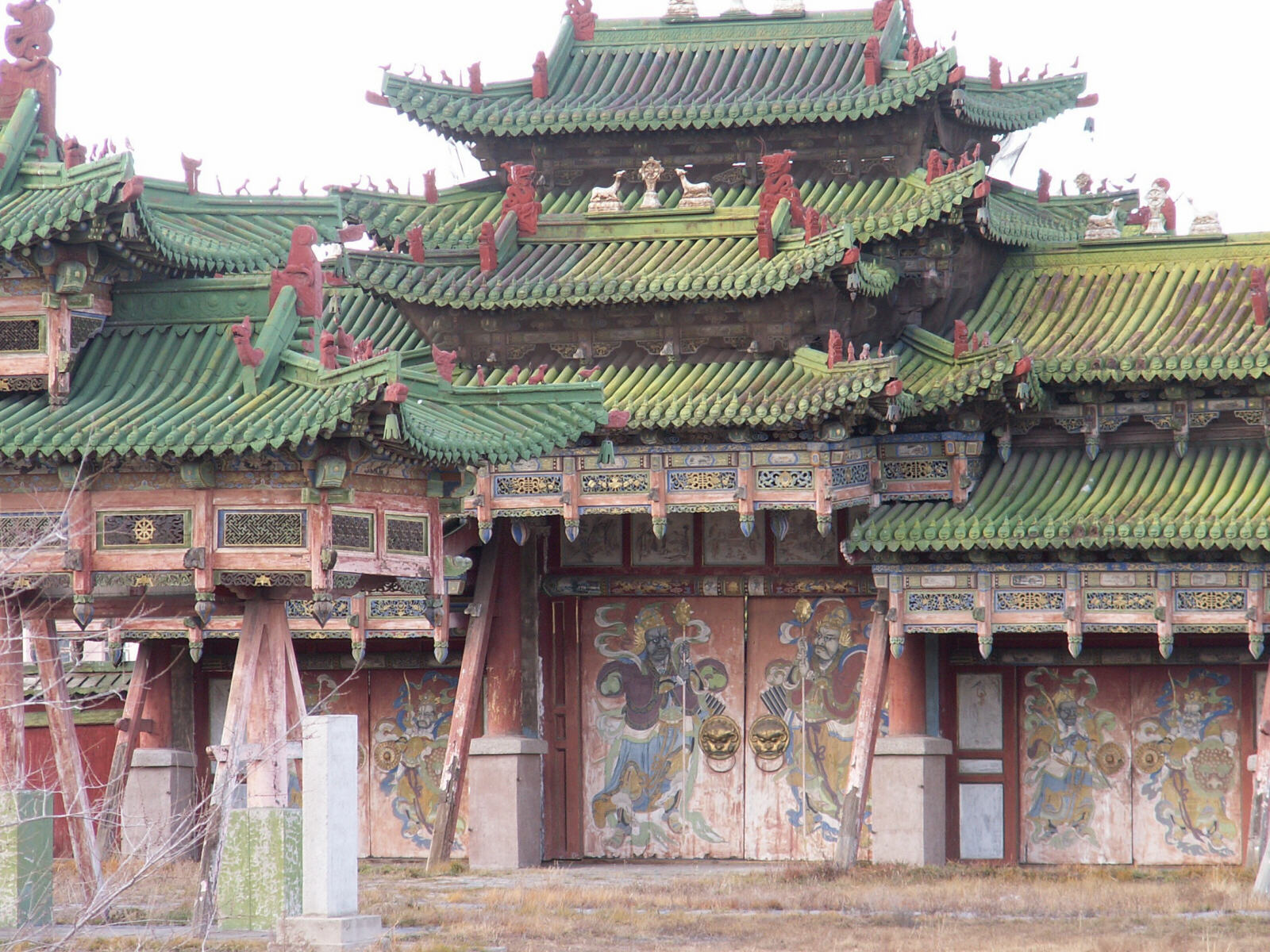
|
Down the street a man was using a mobile phone, Mongolian style.
|
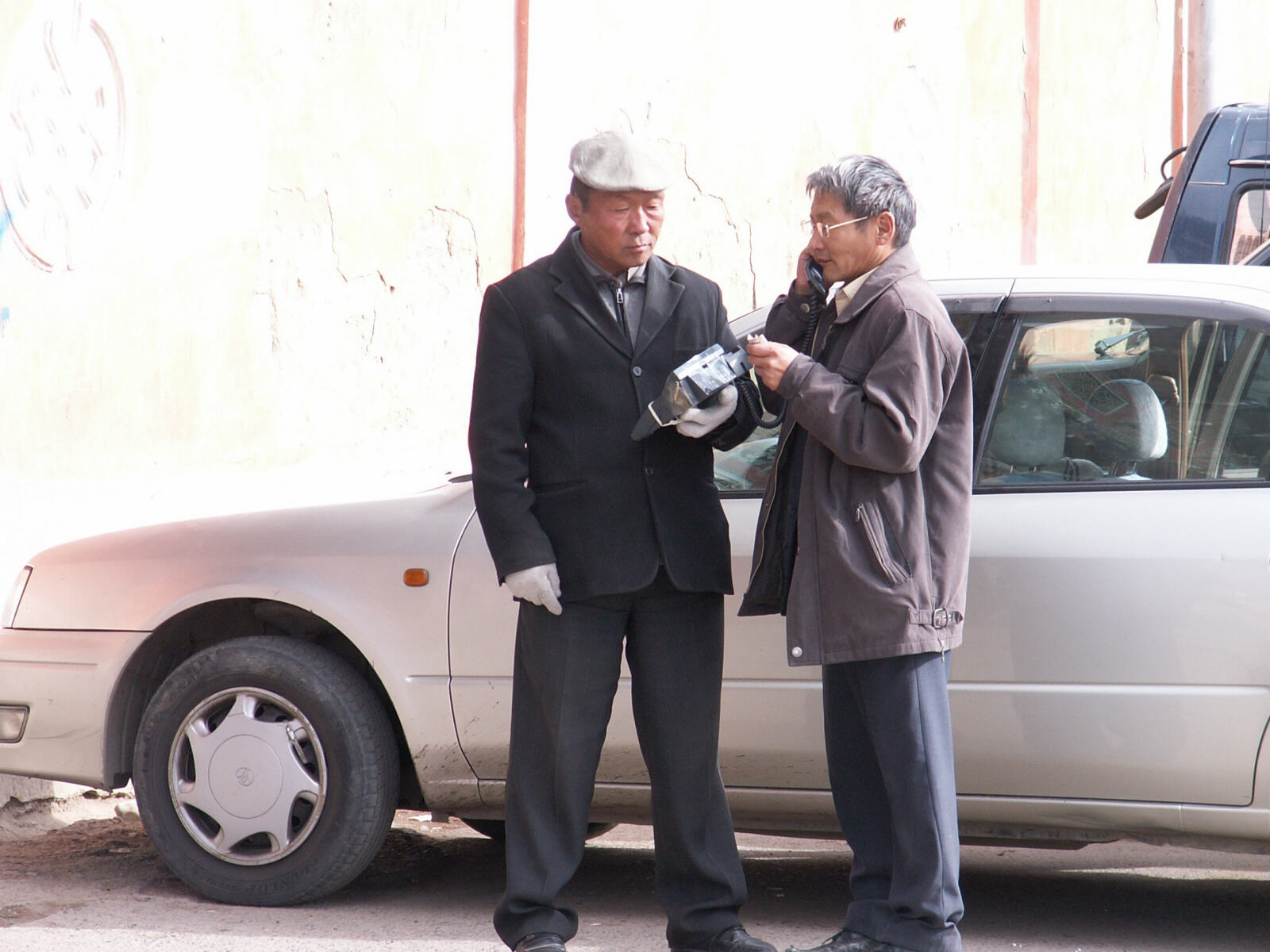
|
In the evening we got a trolleybus into town and went to a Mongolian barbecue restaurant that we had noticed earlier - well, we had to, didn't we! This one turned out to be part of an American restaurant chain and although you could have as many platefuls as you wanted, it wasn't nearly as tasty as the one in Moscow even though we tried six combinations between us. Nevertheless we spent most of our remaining Mongolian money there so rather than get a taxi we waited for a bus which, when one eventually did come along, happened to take us straight to our hotel for 2½ pence each.
Thurs 13th - crossing another border, into China. As we were leaving the hotel we met Jim and Beaufort who had just arrived on the train we were about to catch; we first met them on the train from Brussels to Minsk then again in Irkutsk - everyone follows the same path through the Siberian wilderness! Along with our train ticket we received a voucher for breakfast on the train, which was a pity because we'd just had a big buffet breakfast at the hotel as well as the huge meal last night, so we weren't able to do it justice. We then spent the day crossing the Gobi desert, which changed from bare grassland at first to more or less bare earth, swept by freezing winds which threw up dust storms that we could smell and taste even inside the train. In the early stages we passed occasional tented encampments or herds of horses with solitary herdsmen but later the scenery was utterly desolate. We went to the packed dining car, which was very elaborately decorated with carved woodwork and Mongolian swords and shields, and had a nice Hungarian goulash with salad. Then came the next lengthy border crossing as we crossed from Mongolia into China. This one only took five hours altogether, including being shunted into a shed and hoisted into the air again to have the wheel bogies changed back to standard gauge for Chinese railways. |
Datong, Shanxi province, China
|
We had pre-booked the train and hotels in Russia and Mongolia but now we were in China we were on our own, we had made no prior reservations. We got to Datong at 7:30am and found a man from CITS, the Chinese national tourist organisation, waiting to meet anyone getting off the train. In no time at all he had changed some currency for us, booked our train out tonight and arranged a tour to the two main sights in Datong. The first, Yungang Buddhist caves, 16 km outside town, was really wonderful; a series of caves carved into a cliff face, richly decorated with carved Buddhas of all shapes and sizes from 17 metres tall to just 2 cm high. |
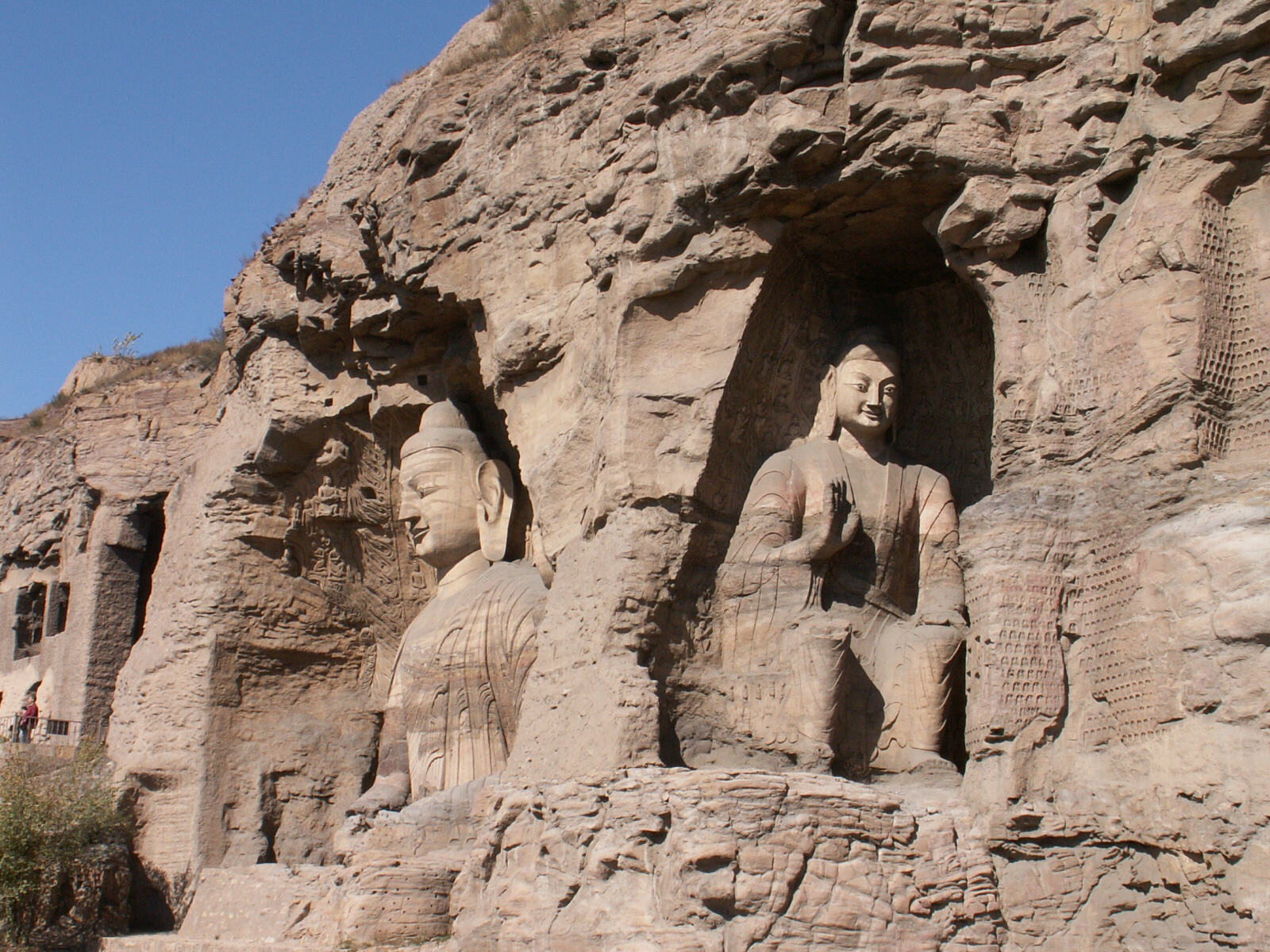
|
Inside cave five at Yungang Buddhist caves. |
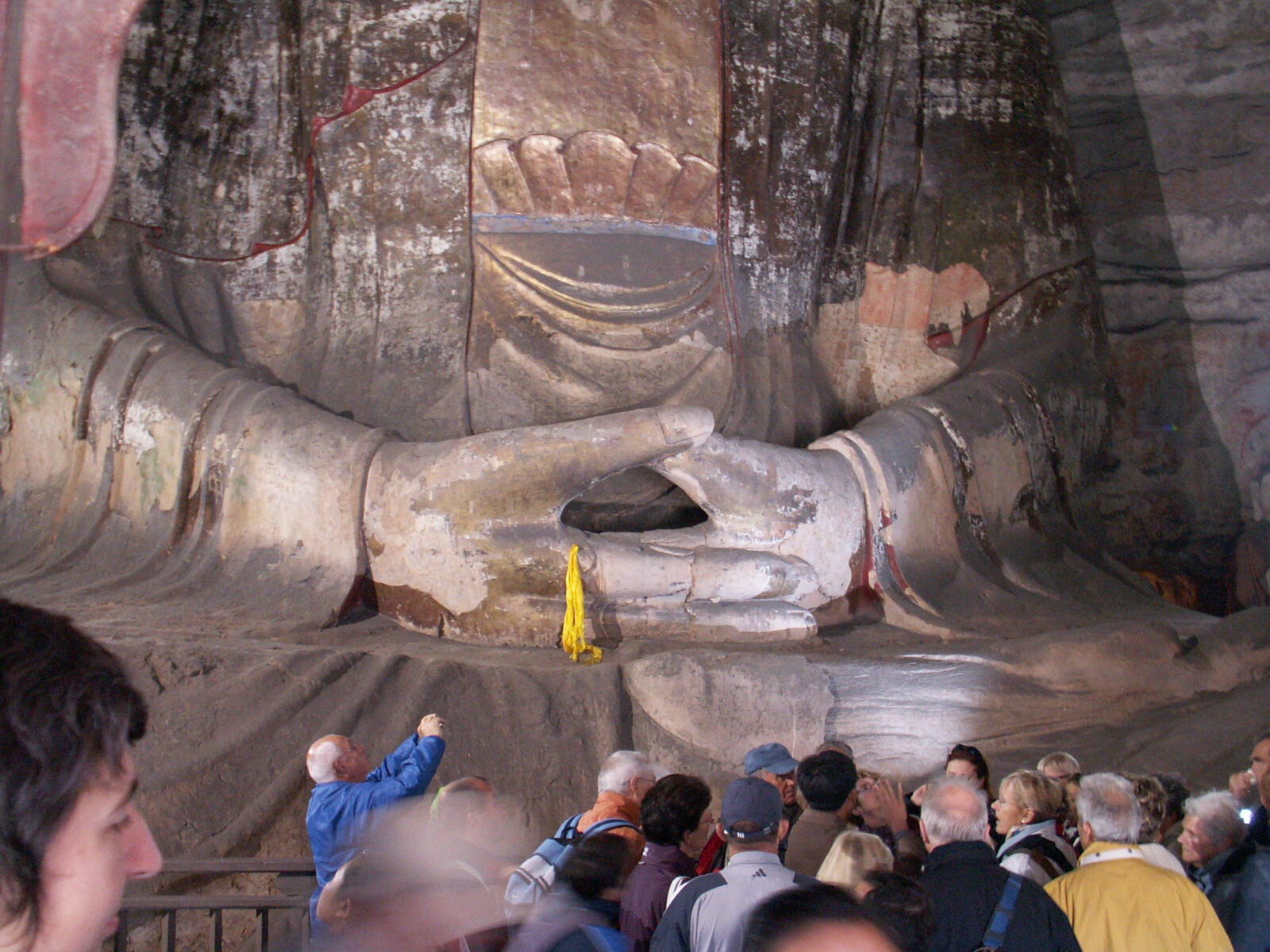
|
The second sight, the Hanging Monastery at Hunyuan 75 km away, was equally impressive - a series of wooden buildings attached halfway up a sheer cliff face and linked by little wooden stairways, it was extremely picturesque as well as providing fabulous views of the valley below. Lunch was a tasty set menu for £1 each in one of the many restaurants nearby. |
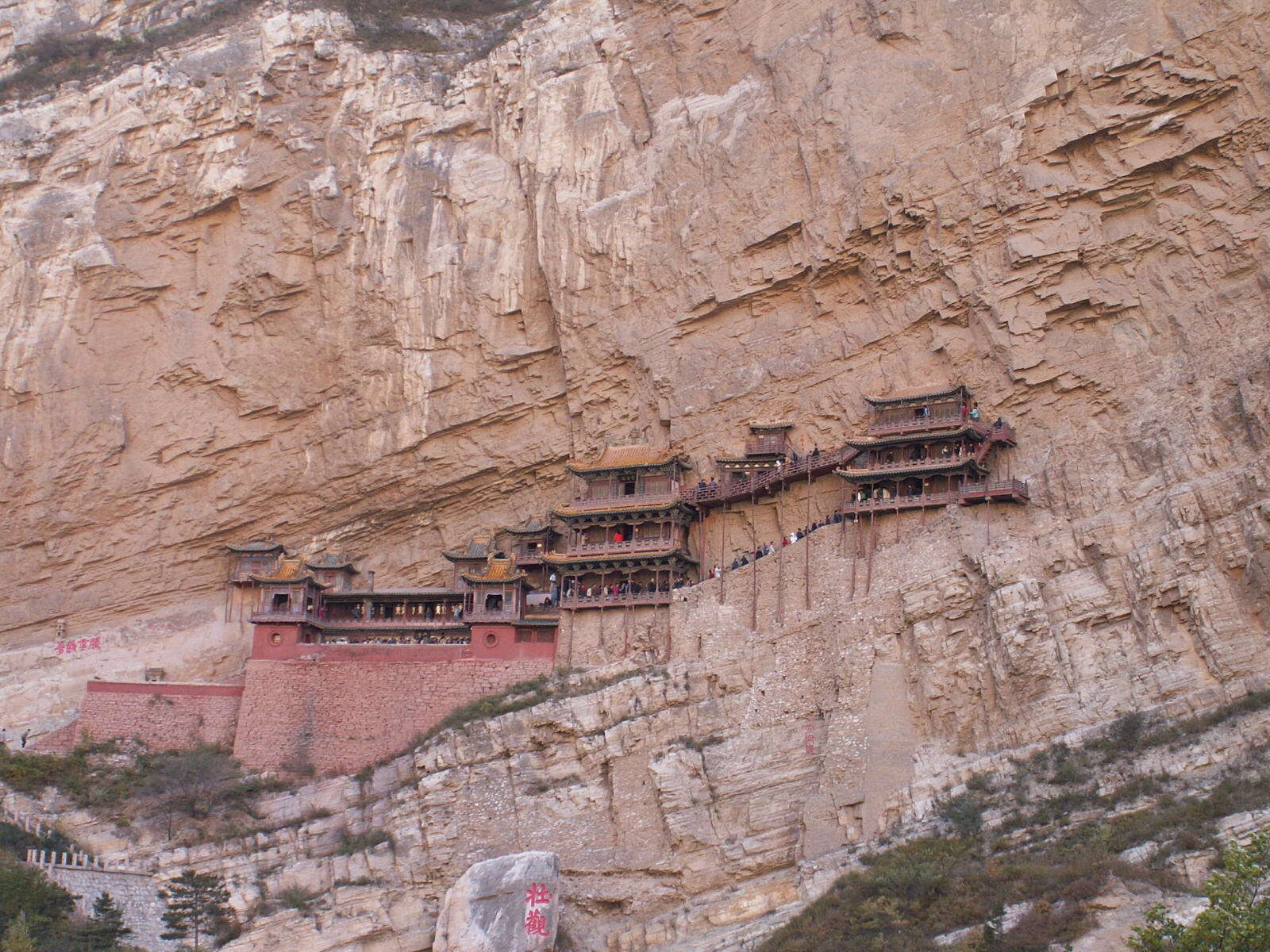
|
That evening we went with Sarah, who had been in the train from Mongolia and the tour with us, to a smart restaurant on Railway Station Square and had a very nice meal of chilli chicken and curried beef. Of course we ordered far too much and had to leave a lot of it, but apparently that's good manners in China because if you eat it all that's an insult to the chef who hasn't given you enough. |
Beijing
|
Sat 15th to Sun 16th. It was an historic moment as we arrived at Beijing Central Station at 5:30am, because we thus completed the epic overland journey from London to Singapore (we had covered Beijing to Bangkok last year and Bangkok to Singapore some time ago).
We were now on familiar ground so we bypassed the predatory station taxi drivers and headed for the Subway where we got the 'circle' line train to the opposite side of the city, much nearer to our intended hotel. We got a taxi for a modest 13 yuan (£1 = about Y13, US$1 = Y8) and checked into the Beijing Yunlong Hotel in a great location in our favourite lively Hutong (back alley). Our room cost Y180 a day, around £14 or $23. The hutongs were still old-fahioned and unspoiled, but the skyscrapers are approaching ominously.
|
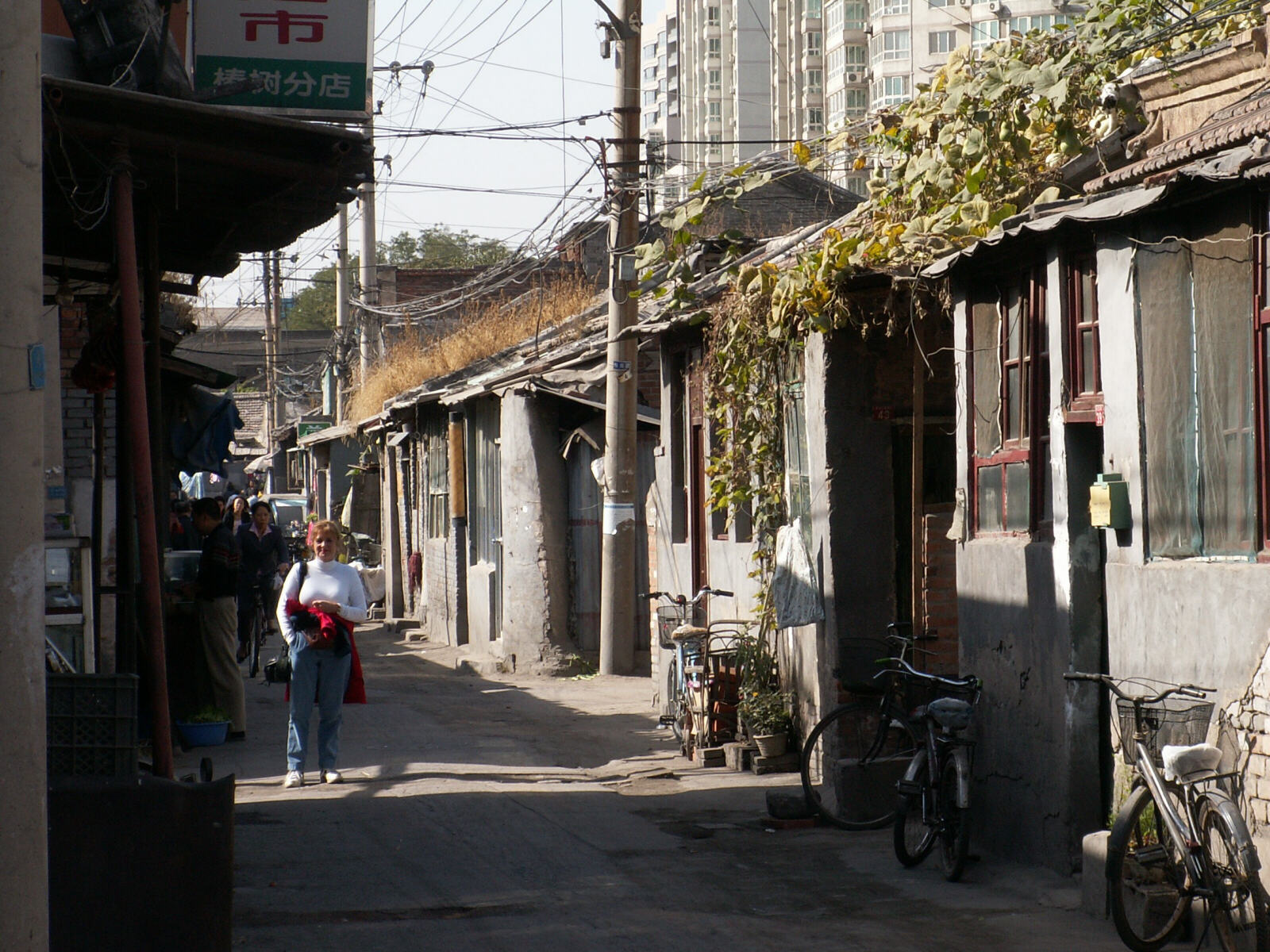
|
By 9am we were unpacked, showered and ready to hit the sights. We got a taxi to Qianmen, at the south end of Tiananmen Square, and walked through the hutongs and bustling shopping streets to the southwest, stopping at a camera shop to put our digital pictures onto CD and at Leo Hostel 2 for brunch of omelette and pancakes. This tableau was outside a restaurant in Dazhalan Street near Qianmen. |
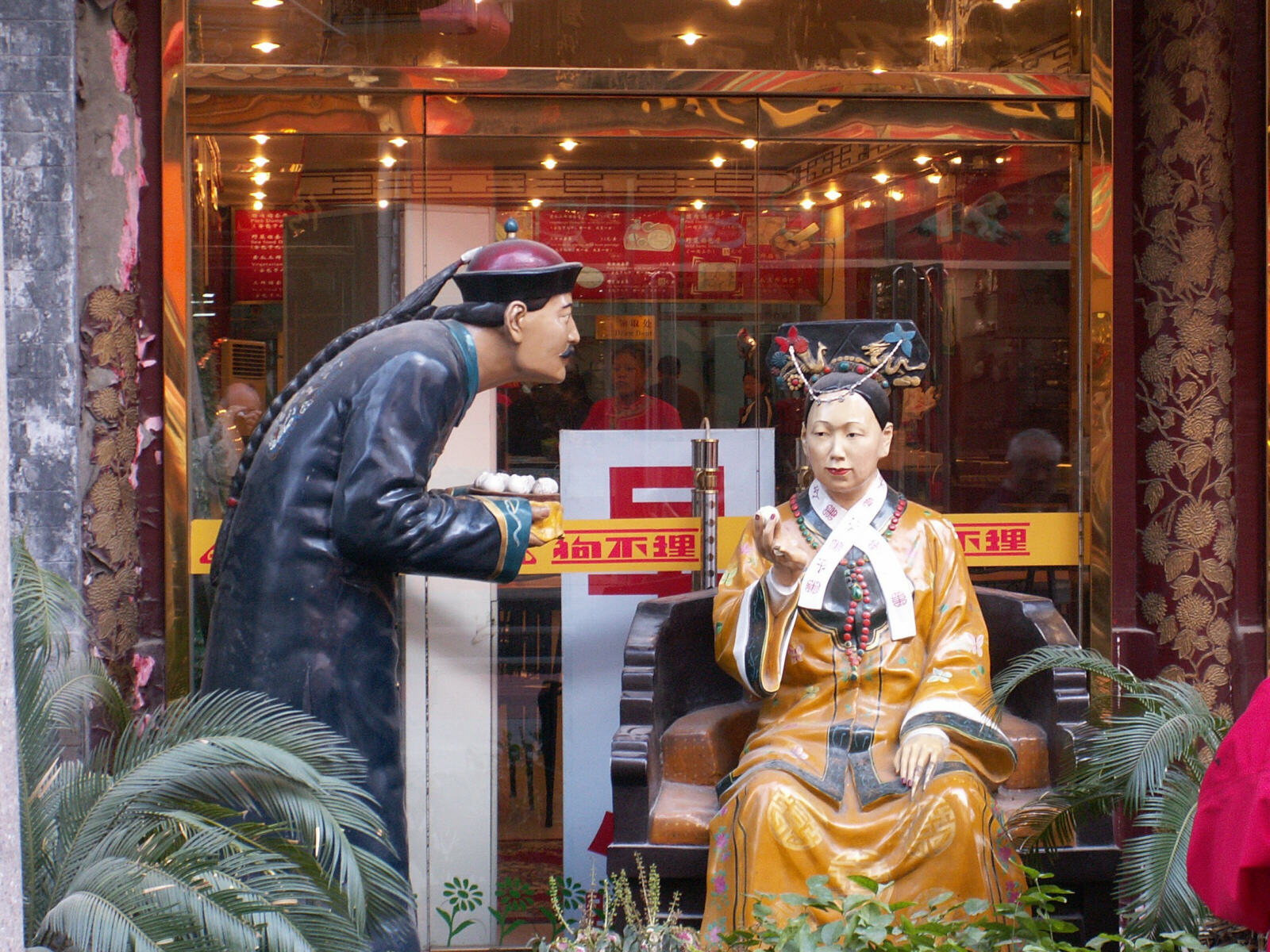
|
We ended up at the Cow Street Mosque which looked just like a Chinese temple except for a few Arabic inscriptions, and which was undergoing major renovation work - it was one huge building site. We were now exhausted so we got a taxi back to the hotel (Y25). Last year in Beijing we established an evening routine of walking down the hutong to the lake, having a beer in a bar overlooking a busy bridge, then an Indian meal at the Raj restaurant on the way back. So we set out to repeat the process, and the bar owner recognised us immediately which was nice, and we sat and chatted with him like old friends in his new rooftop seating area (last year he still had a normal roof!). Then at the Raj the owner also recognised us immediately which was nice, and we chatted with him before having another wonderful meal.
On Sunday we had a relatively relaxed day, walking around the main shopping streets to the west of the Forbidden City. As well as big expensive department stores we found a side alley called 'Ancient Custom and Culture Street' with lots of old-style stalls with food and other products. At the end of the street was a stage where ladies were singing incredibly loud and shrill Chinese opera and some men invited us to sit at their table and share warm beers with them, which we did for as long as we could stand the noise. In the evening another street was full of food stalls selling the most amazing array of snacks, from tasty-looking spring rolls and meat kebabs to less appetising silk worms, snakes and scorpions - the ones that upset Sheila most were the six-inch long millipedes on sticks and three-seahorses-on-a-stick. After considering the matter carefully, we went back to the Raj Indian restaurant for dinner. |
Tianjin, China
|
Mon 17th and Tues 18th. We checked out of the hotel, walked down the hutong to collect the rest of our cleaning from the laundry and got a taxi to central station where we got the train to Tianjin. It was a very modern, fast, double-deck train and we were there in 1½ hours. There were no great-sounding hotels in the guide book and no touts at the station so we walked out of the station and by lucky chance the first hotel we found nearby, the Xin Long, was really good value - we got a nice room on the 7th floor, complete with a bathroom with an actual bath, for Y188. We got a taxi to 'Ancient Culture Street' which is supposed to be an attempt to recreate the appearance of an ancient Chinese city but was actually filled with rather tacky gift shops where Sheila bought yet another Buddha's head. This strange statue was outside a chinaware shop in Ancient Culture Street. |
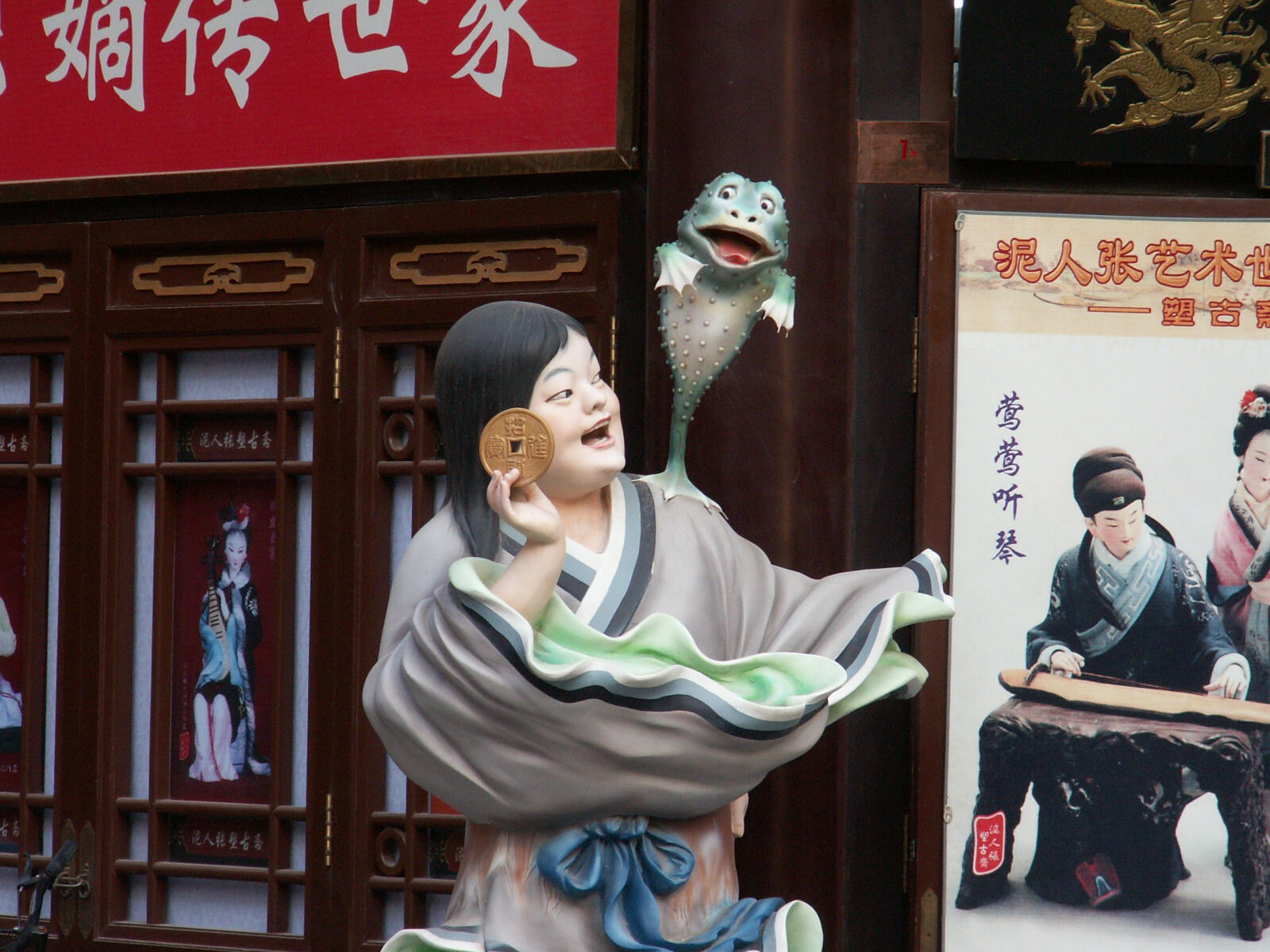
|
As it got dark we got another taxi to 'Food Street' which we hoped would be full of street stalls like the night market in Beijing but this was also rather disappointing, containing a series of garish Chinese restaurants, so in the end we went to a Pizza Hut and had an extremely good pizza. On a roundabout between the hotel and the railway station was the illuminated 'Century Bell' clock tower. |
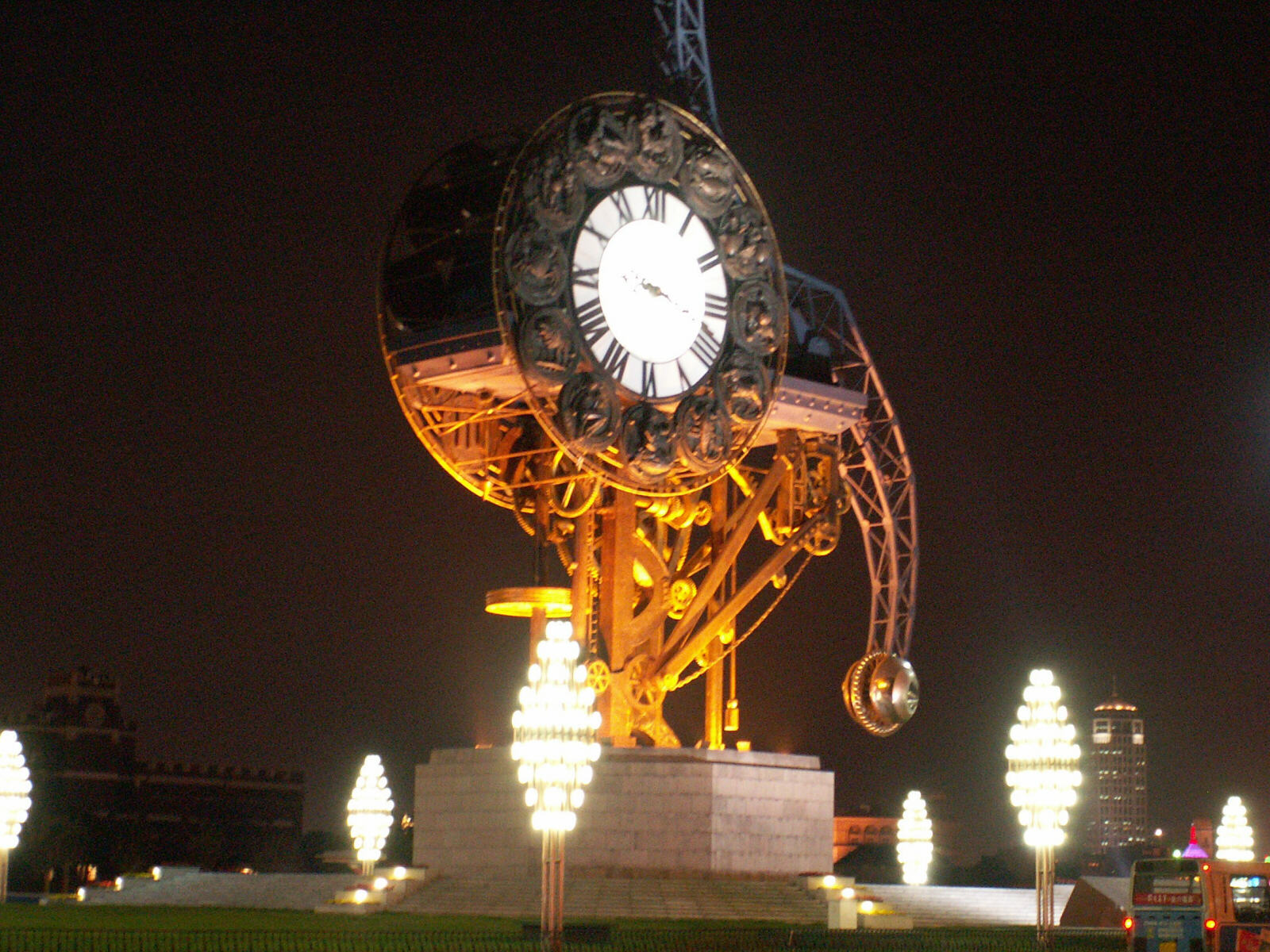
|
Breakfast on Tuesday was included at the Xin Long hotel and it comprised a fried egg sandwich to be eaten with chopsticks (no mean feat) and a glass of warm milk, sitting on settees in the second floor restaurant, watching the traffic ebb and flow round the big clock tower roundabout outside the hotel. We set out to find Chinatown, described in the guide book as a people-watching area with lanes and side streets where traditional architecture remains. Unfortunately it has all been redeveloped since then, meaning the whole area has been flattened and a sterile 'ancient culture' type of street of tacky gift shops built in its place. China changes so fast that you can't afford to have an out-of-date guide book. We went to see the Astor Hotel and there at least, tucked away inside the new ultra-modern block, was the old hotel building full of dark wood panelling and 'English Royal style staircase', as they describe it. We sat in the railway station for a while watching the world go by then caught the overnight sleeper train to Nanjing. As soon as the restaurant car opened at 6pm we took up our places and by watching what everyone else was having, managed to order a very tasty meal of Sichuan beef hot pot, prawns with cucumber, rice and of course, beer. |
Nanjing, Jiangsu province
|
Weds 19th and Thurs 20th. We arrived about 7am and this time there didn't seem to be any hotels adjacent to the railway station, so we were just wondering what to do when a hotel tout came up and took us to the nearby 'Nanjing Hongshan Meeting Centre Hotel' which was very good value for Y180 including breakfast and he even paid the taxi fare. You always get a flask of piping hot water in Chinese hotels so we had a home-made breakfast of soup and tea, then set out to see Nanjing. We got a taxi right across town to Zhonghua Gate, one of the surviving Ming city gates with a section of surviving city wall. The gate and wall were both huge; massive brick constructions that looked as if they could withstand any amount of siege and bombardment. Nanjing once had 33 km of wall, the longest city wall ever built anywhere in the world.
This is a brick in the wall at Zhonghua gate - every brick had to have the maker's name and address embossed in it, so if it broke they had to supply a replacement. The Chinese are certainly good at building walls! |
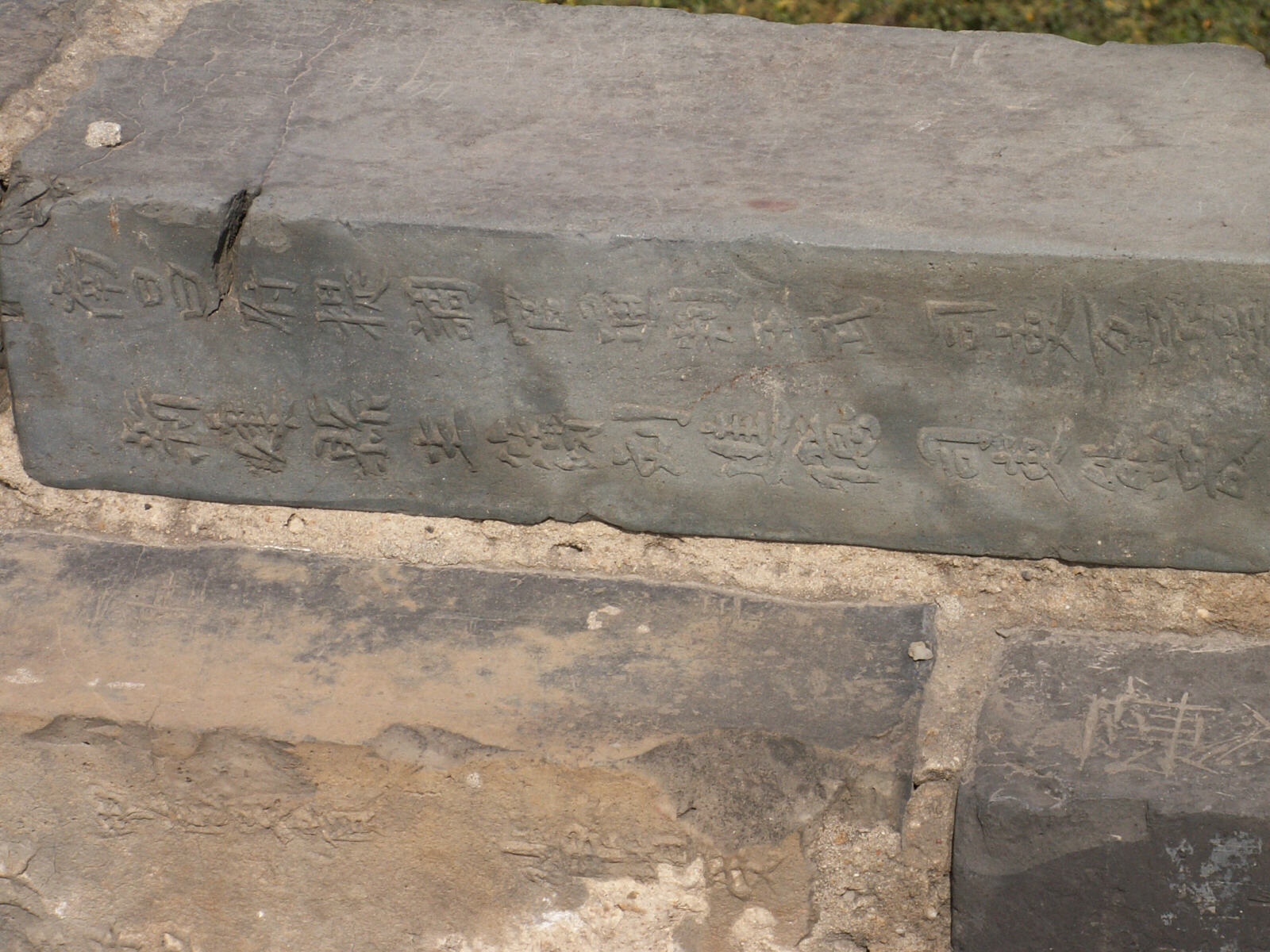
|
We walked to the nearby Fuzimiao district which is a lively shopping area and has boats for hire on the canal, so of course we had to have half an hour zig-zagging up and down the canal in one of the little electric boats. It was all very picturesque and colourful and we decided to stay in Nanjing for an extra day so that we could do it again tomorrow. Next we got a subway train to Xinjiekou, the crossroads at the centre of town where we had noticed a Pizza Hut restaurant! We sat in the window on the second floor watching people go by in the street outside as we enjoyed another excellent pizza. We also enjoyed some beers, which is a mistake at lunchtime because then all we wanted to do was snooze the afternoon away.
Eventually we pulled ourselves together and as it got dark we walked down our hutong - the hotel was in a fascinating back street north of the railway line - and down to the park in front of the railway station. There we saw the most amazing array of coloured lights twinkling and flashing in the sky, which turned out to be on about 20 big kites each about 15 feet (5 meters) across, being flown by people standing around in the park. We got the subway back to Fuzimiao and walked around the shops and canalside, which were still buzzing with activity and even more brightly lit than during the daytime, if that's possible. |
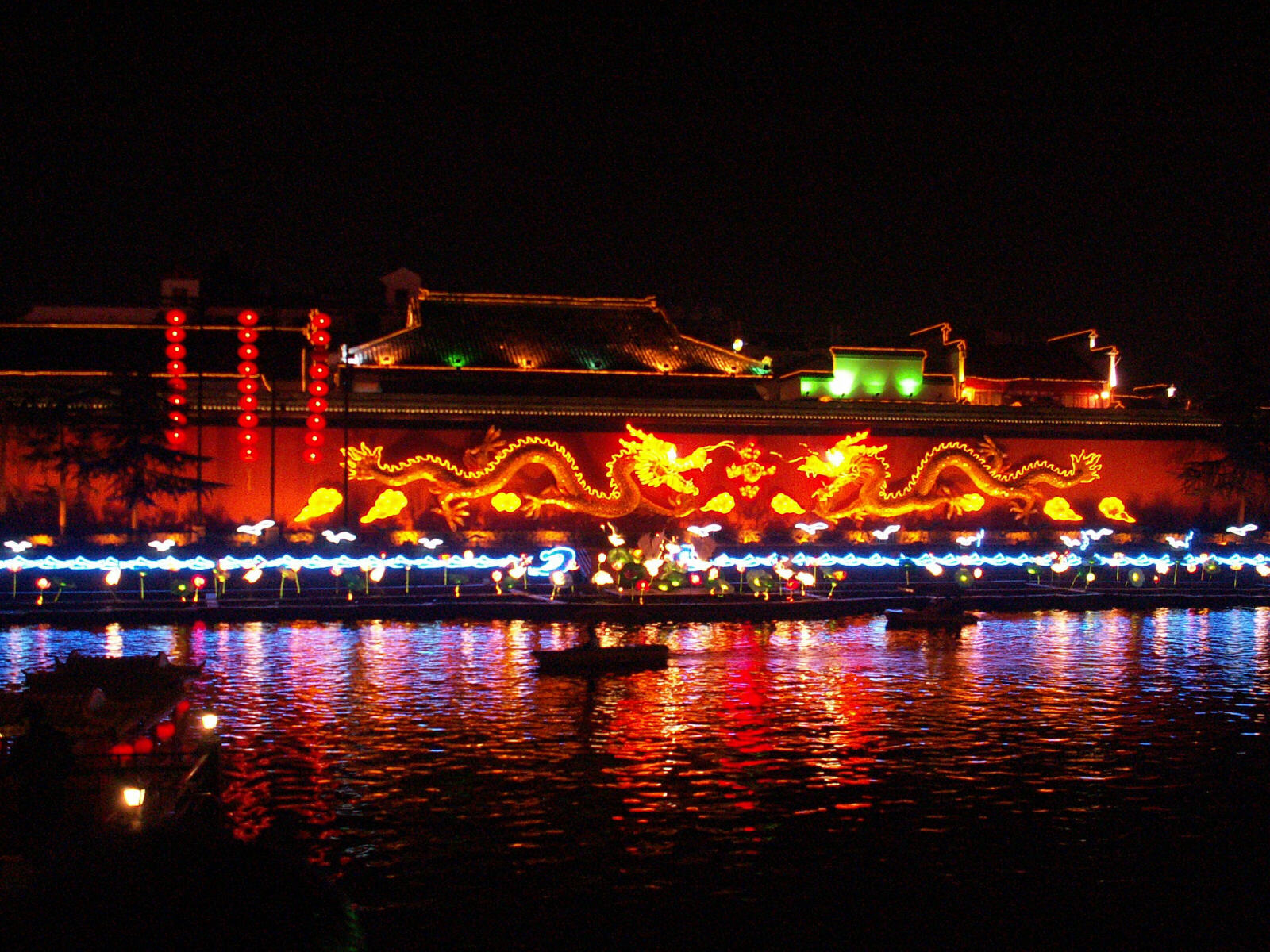
|
The next day we set out to get the subway train into town but we didn't get very far - we walked round by the lake near the station and found more little electric boats for hire, so we went for an hour on the lake, weaving in and out of the islands. Then we got the subway to the end of the line where the Olympic stadium is, and found crowds of people and touts selling tickets to the Chinese National Games which were being held there, but it didn't seem as though any of the events started until the evening so we didn't go in. We got the subway back to the Drum Tower on a hill in the centre of town, then went back to Fuzimiao district. It was about 5pm when we got there so we sat in a restaurant drinking beer and eating the plates of peanuts and spicy beans that they kept bringing us, then when it was dark we went to the canalside where the flashing lights and neon signs were at their most garish, and had another half-hour boat ride down the canal to the Ming city gate and back. It was great fun. |
Suzhou, Jiangsu province, one of the 'water towns'
|
Fri 21st to Sun 23rd. We caught the train to Suzhou, which was very fast and comfortable and we were there in 2½ hours. At the CITS tourist office in the station they recommended two hotels, a cheap one and an expensive one, so of course we went to the cheap one for Y168, the Ban Yuan hotel which was rather run down but conveniently located within the town. We went for a walk round Suzhou and found that there are canals everywhere, with occasional boatmen drifting about fishing out any leaves or debris. This boat is on the canal by Ping Jiang Road. |
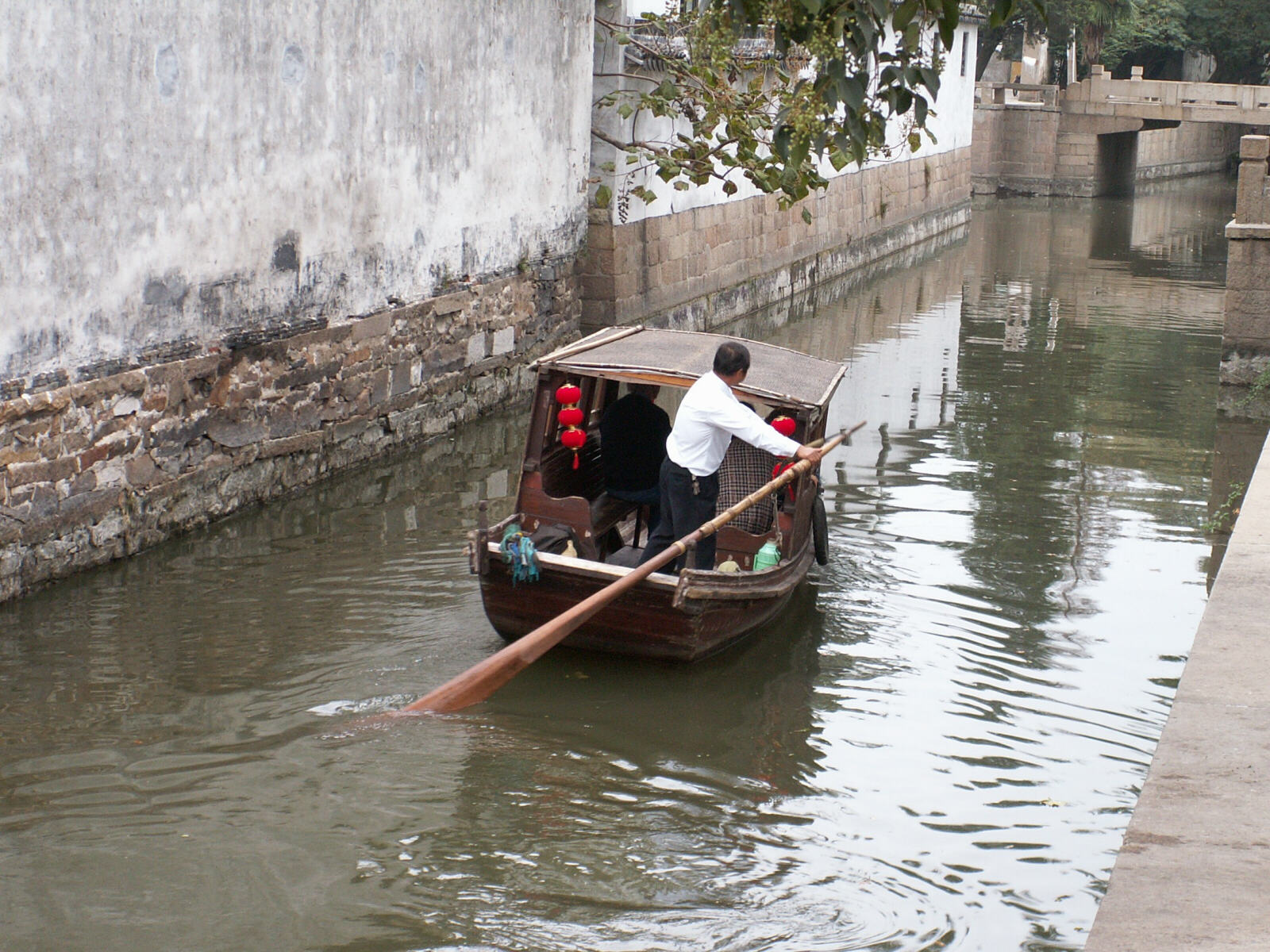
|
The centre of town, around the 'Temple of Mystery', was very lively, with shops and restaurants and of course lots of flashing neon lights. We walked down to the 'steamer company' office on the south moat and booked a boat to Hangzhou for the day after tomorrow, then caught a 103 bus back to the centre. We had a beer in one of the many restaurants then went to another restaurant nearby which seemed to be the place to be - it was enormous, on three floors with countless separate rooms and dining areas around big fake trees that made it seem like dining in a forest. There was a queue to get in and when we finally sat down and ordered we weren't too successful - we ended up with a whole duck complete with its head, a bowl of spicy chicken skin and some rather rubbery beef strips in batter. It was an interesting experience!
Saturday was another nice day sightseeing in Suzhou. We went to the Humble Administrator's Garden, one of the classic Chinese gardens laid out in the 1500s, with lakes, pavilions and winding paths. It was packed with Chinese tourists, so not exactly a place for quiet contemplation as originally intended, but it was very enjoyable. |
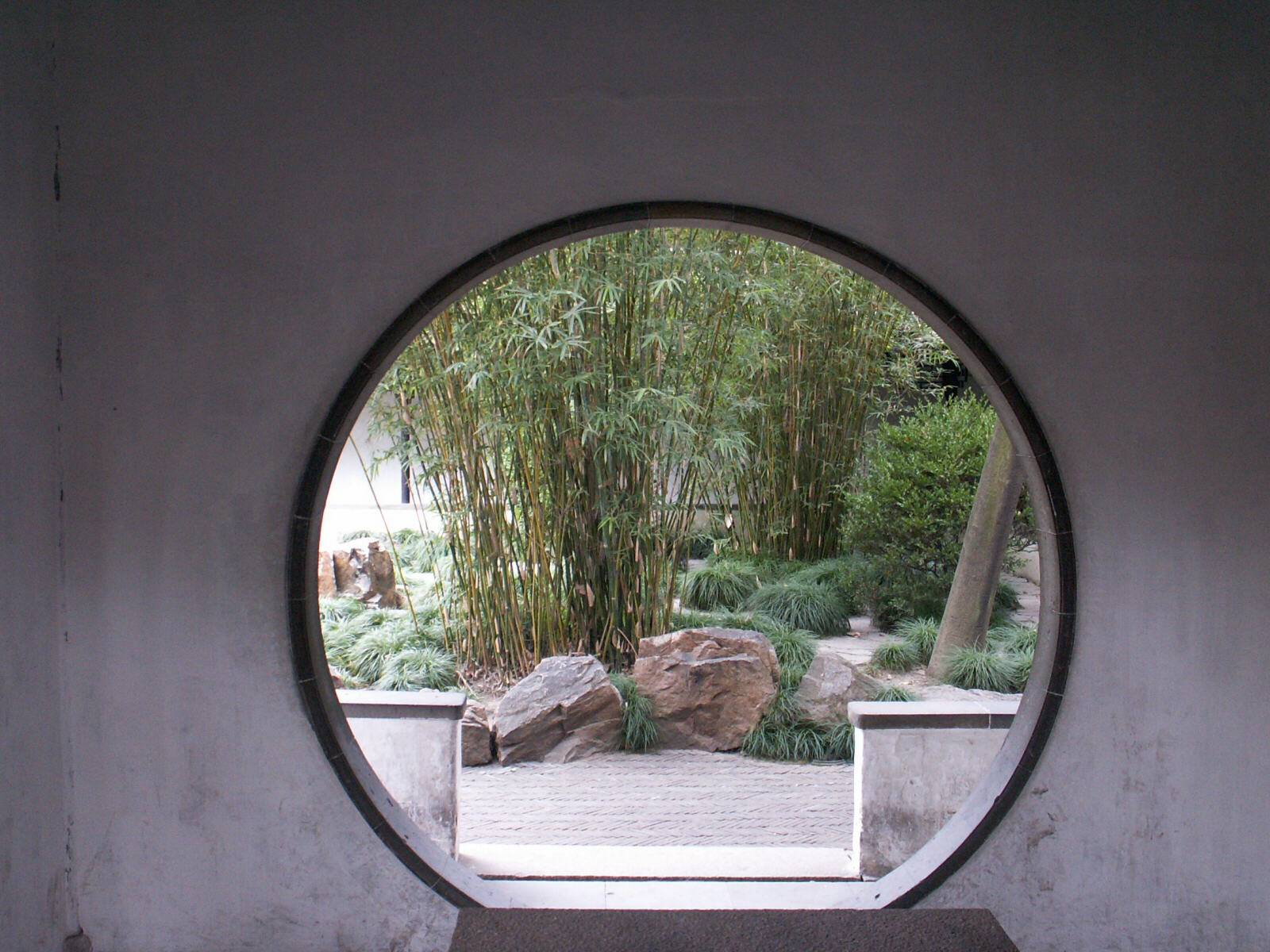
|
We had a Chinese lunch at a restaurant picked at random as we passed by, then went to North Temple with the tallest pagoda in south China but it was surrounded by scaffolding and closed for renovation, so we went to the nearby Silk Museum but it was also closed for repairs. We got a taxi to the other side of town and went to the 'Panmen Gate scenic zone', a newly created garden built around a surviving city gate and an old pagoda nearby. This was also a very pleasant garden and in particular we enjoyed feeding the hundreds of huge Koi carp in the lake, which went into an absolute feeding frenzy, thrashing around and splashing the onlookers. |
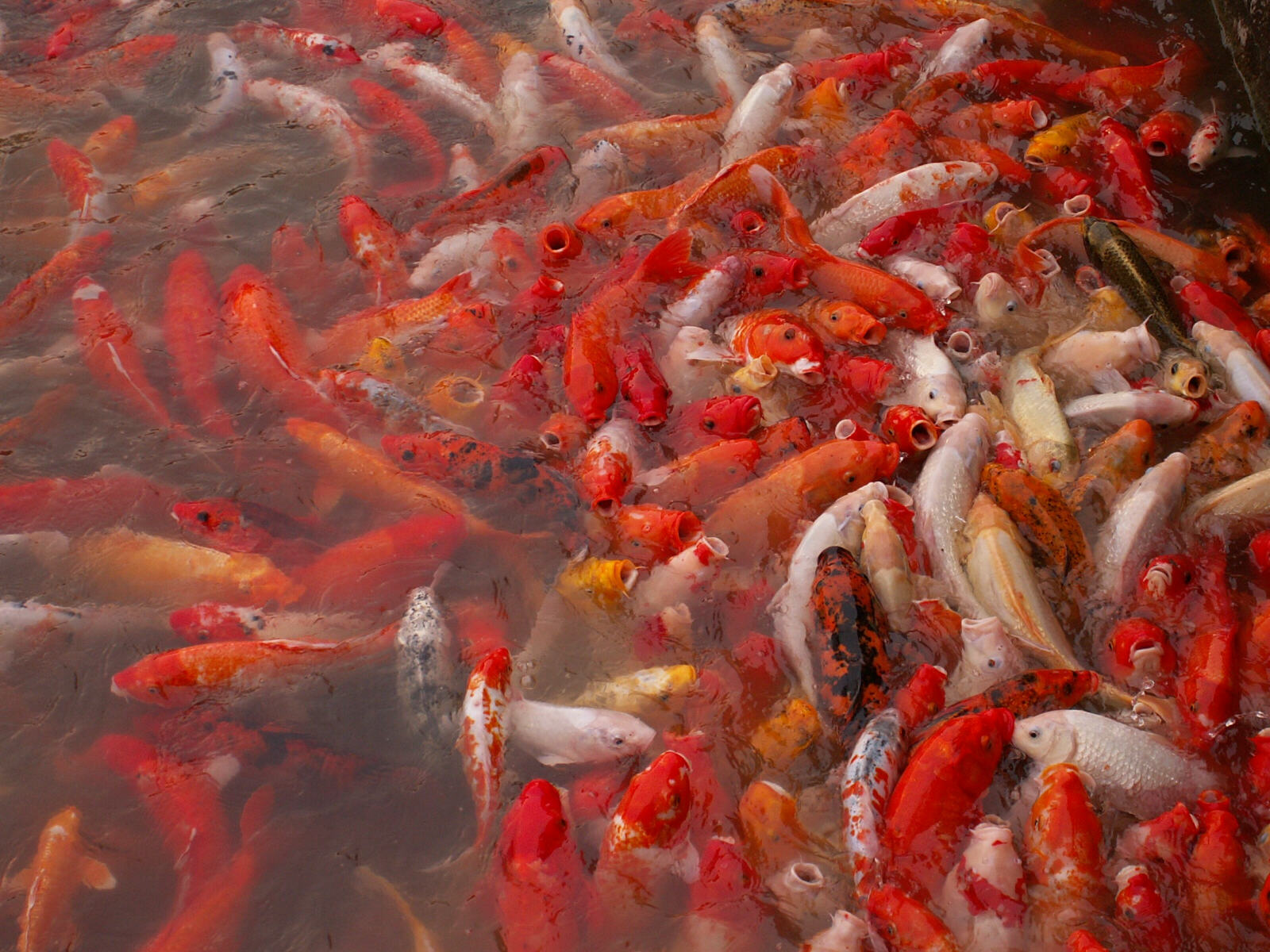
|
The city gate was also interesting because it comprised a 'land gate' and also a 'water gate' with two sections so that the gatekeeper could inspect the boats as they entered the city. Walking around the centre of town in the evening we found a real gem, the Sicily Restaurant, with a bar downstairs that served Erdinger black beer and a restaurant upstairs with wonderful pizza.
On Sunday we took our bags and left them in the left luggage office at the steamer dock, then we carried on sightseeing in Suzhou. We went to the Garden of the Master of the Nets which is supposed to be the best garden in Suzhou but we didn't think so, and any tranquillity was ruined by the tour guides shouting through electric megaphones and the crush of tourists trying to cram into the tiny garden. Back in the centre of town Sheila had a hairdo - she never learns, it was just like last year when the hairdresser violently massaged her scalp and stuck various things in her ears including fingers and little scoops. Then we went to the Temple of Mystery, a Taoist temple right in the centre of town. It was spread over several buildings in amongst the shops (or the shops were in amongst the temple) and in each building people were lighting huge bundles of joss sticks and putting them in a burner to fill the air with smoke. |
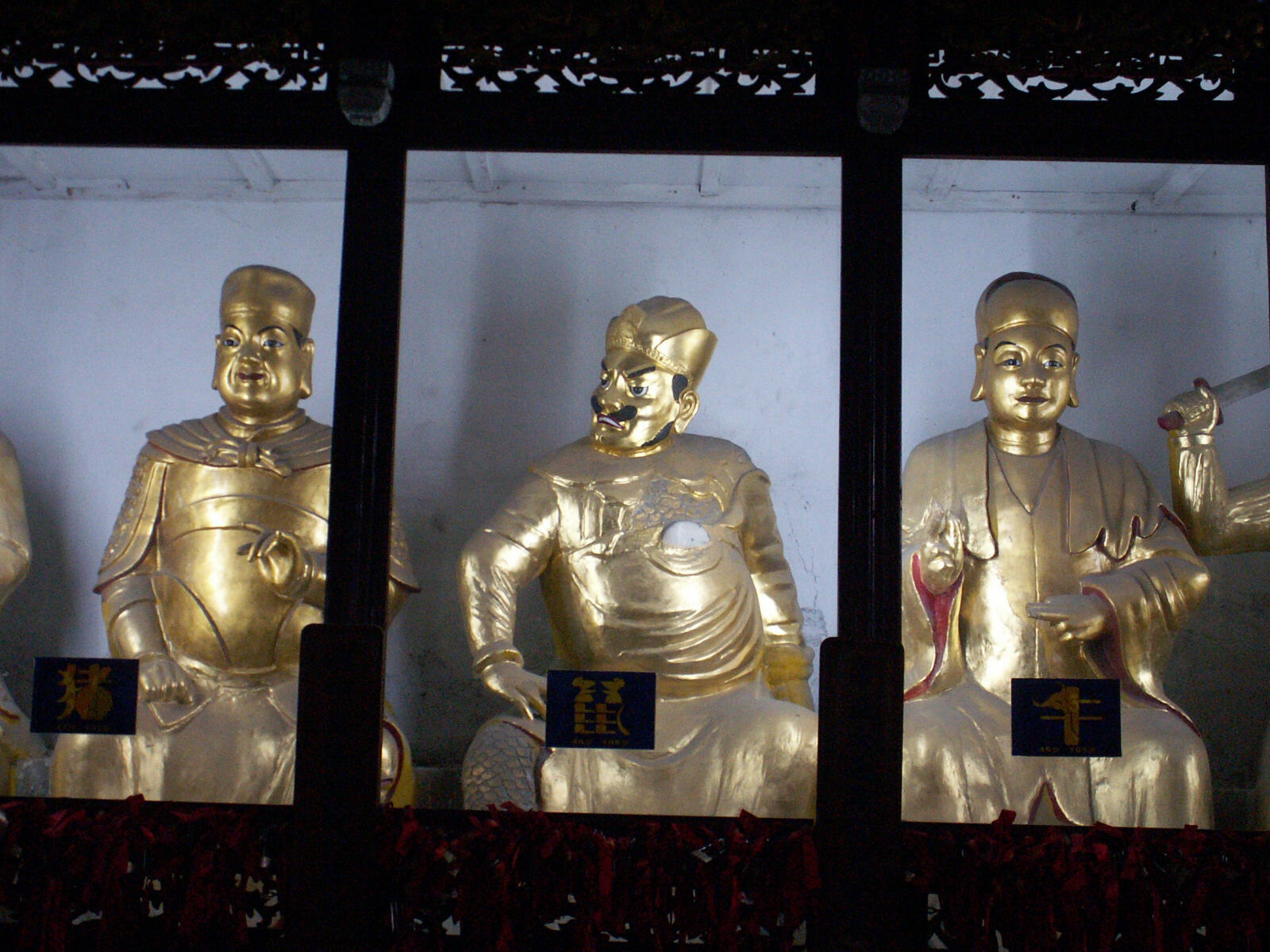
|
We returned to the Sicily restaurant for a late lunch/early dinner and then went back to the dock and embarked on the steamer to Hangzhou. Unfortunately it was getting dark as we set off, because the canalside life and the boats were fascinating, and we passed another part of the old city wall and later the 'Precious Belt Bridge', one of the most famous ancient bridges on the Grand Canal. Our two-berth cabin was really cosy and we lay in our bunks watching the barges go by on the canal before dozing off. |
Hangzhou, Zhejiang province, another of the 'water towns'
|
Mon 24th. After a really good night's sleep on the boat we arrived in Hangzhou at daybreak, about half an hour ahead of schedule. The only hotel tout at the boat dock was an old lady with photos of a nice-looking hotel. She negotiated down to Y180 very quickly, then set off and took us on a route-march across town to a very scruffy hotel that was nothing like the pictures. Nevertheless, the people were nice so we stayed and they made a special effort, sweeping the empty cigarette packets off the stairs for us. They let Sheila use the rooftop washing machine - what a treat, clean clothes! We take things so much for granted at home!
We got a taxi to the north end of West Lake and got a boat trip - Y45 for as long as you like, hopping on and off different boats to explore the islands. The biggest island, Xiaoyingzhou, was lovely, it was set out in a double figure of eight enclosing four lagoons, with pavilions and zig-zag bridges as you walked around. This is one of the Santanyinyue towers in West Lake (yes, that's a real bird on top). |
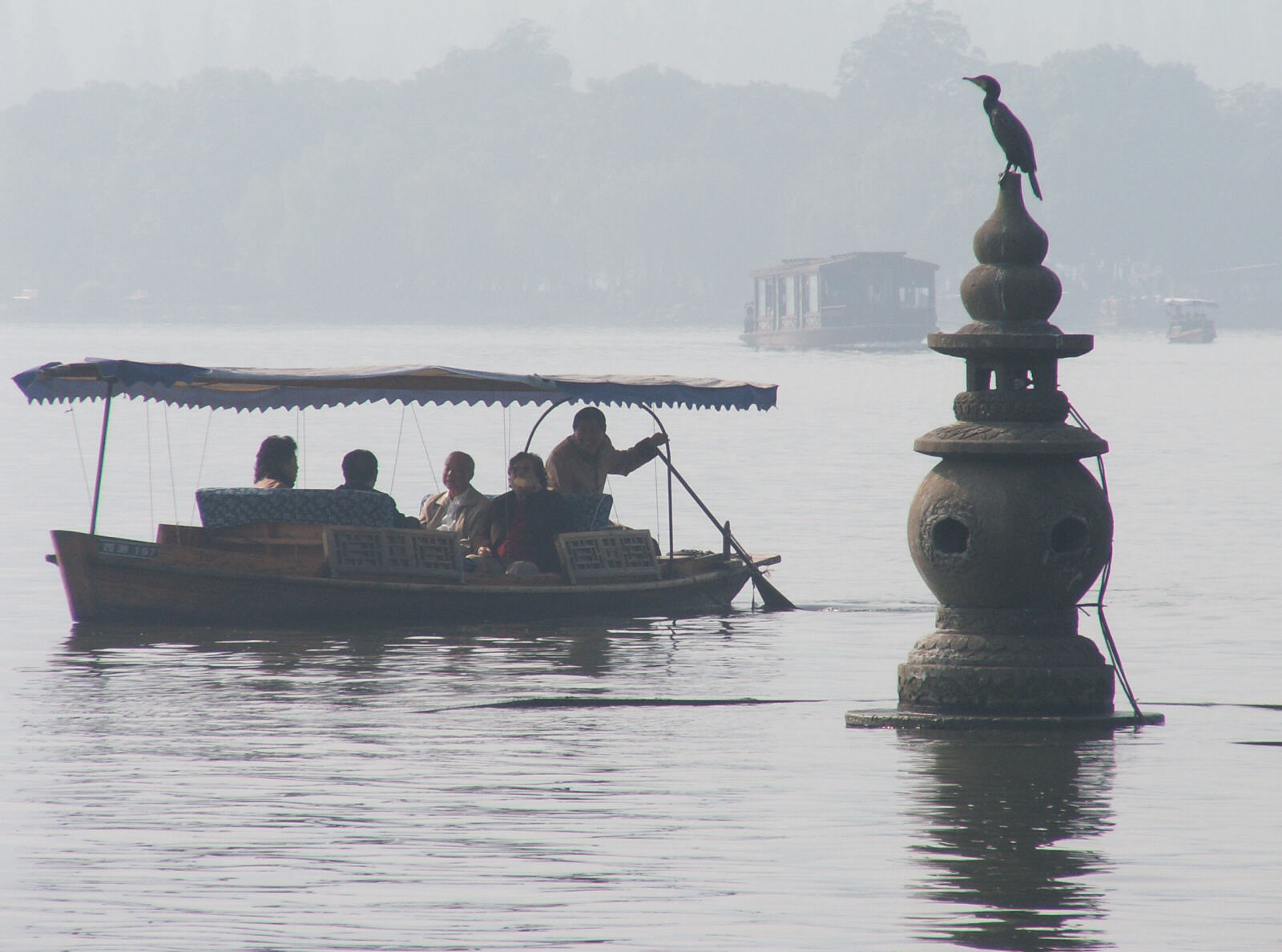
|
The morning mist cleared and the day became warm and sunny. Eventually we completed our trip with a boat to the eastern, city side of the lake, and found that the eastern shore was a very smart corniche, backed by up-market coffee shops, bars and restaurants. We stopped at 'Blenz' and had cappuccino and gateaux. In the evening we went to the 'Temple of Inspired Seclusion' on a hill to the west of town. It was great, with several halls ranged up the hill containing big Buddha statues and a hall off to one side with an amazing collection of Taoist-style statues, all different with expressive faces and different poses. A service was in progress in the main hall with bells and drums, and people were lighting joss sticks and worshipping at each of the halls. It was very atmospheric, especially after the megaphone-toting tour guides had gone and we were amongst the last to leave. The only drawback is that you have to pay twice, Y35 to get into the park and Y30 for the temple. |
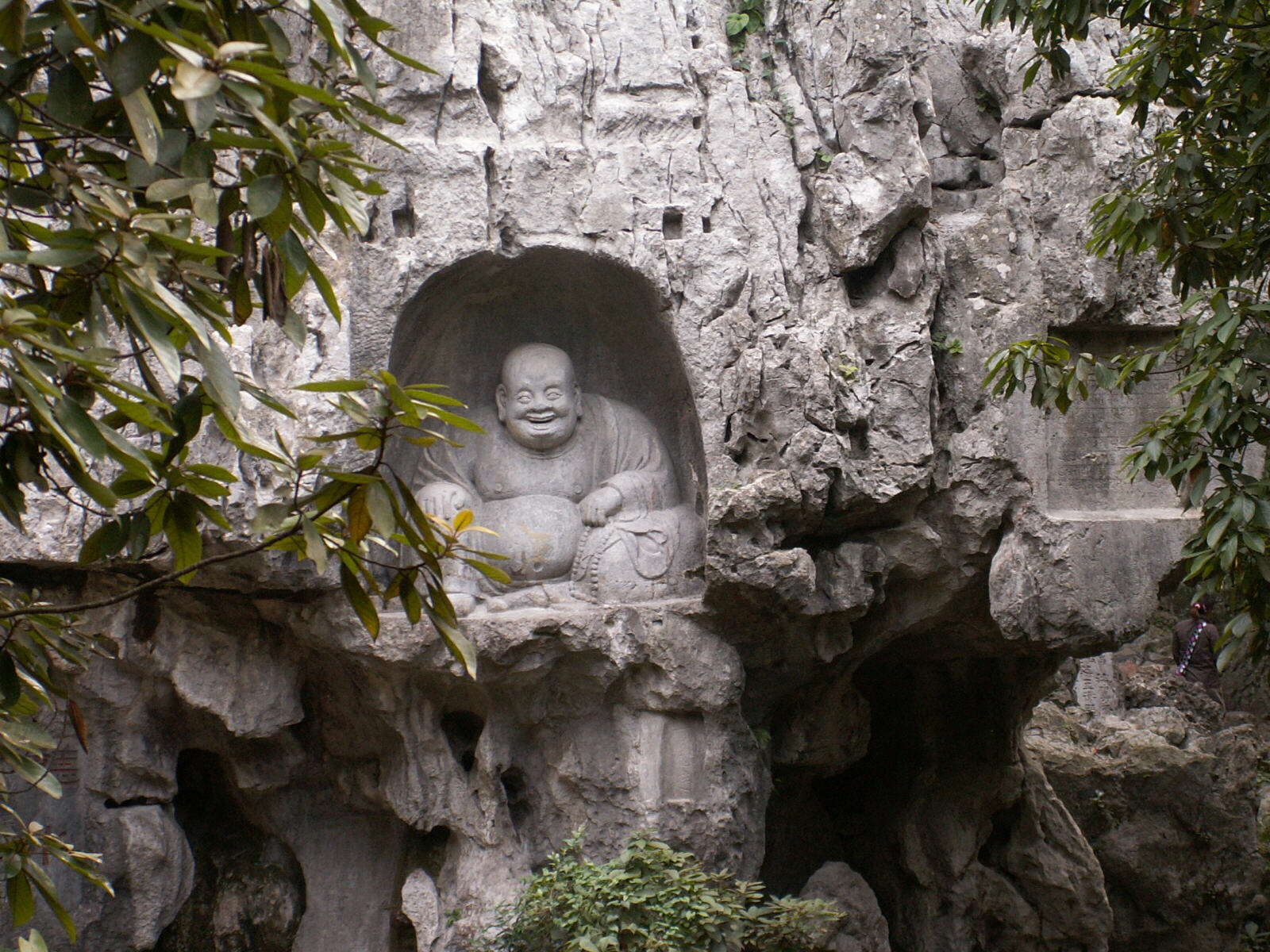
|
There didn't seem to be any taxis available so we got on a number 1 bus that was waiting at the park entrance and it went back to the city, going halfway along the smart east side of the lake before it turned off, so we got off and started strolling along by the lake. Almost immediately we found a bar that had Erdinger black beer, even though it was very expensive at £4 each, so we had to stop and have beer and sausages for dinner. Afterwards we continued walking up the lakeside promenade, past little improvised karaoke sessions with people playing musical instruments and singing, until we saw a crowd gathered and an audience on seats facing the lake. Just as we got there to see what was happening, an orchestra started up and illuminated fountains started playing in the lake, making fantastic coloured patterns as the lights changed and the fountains rose, fell and changed direction in time with the music. It only lasted about ten minutes but it was really impressive! |
Shanghai
|
Tues 25th to Sat 29th. The weather was not so nice today so we decided to move on and went down to the station and got the train to Shanghai. When we got there we couldn't find the CITS tourist office that was supposed to be at the station and surprisingly there were no hotel touts, so we got a taxi to the Astor House Hotel right by the old bridge across the creek in central Shanghai. The Astor is a lovely old colonial-style hotel, at $60 a night, and we had booked Thursday and Friday there on the Internet when we were in Beijing. Now we thought about having an extra couple of days there as well but it turned out they were full, so we went outside to a waiting taxi driver and managed to convey 'd'you know a cheap hotel nearby?'. He took us just down the road to the Hua Lun hotel which was not bad for Y280 the first night, with a discount to Y240 the second.
On our way to British Airways' office to reconfirm our flight we saw a Taco Bell restaurant near Renmin Square so we gave in to the urge to have a Mexican lunch, which was rather ordinary. We had a ride on the metro to check out our route to the airport, then had a walk along Nanjing Road, one of the main shopping streets, where we found a New Zealand ice cream café. In the evening we criss-crossed the town, going to the bazaar and 'Shanghai Old Street' area near Yuyuan Gardens to shop for joss sticks, then back to the Captain Hostel rooftop bar just off the Bund, for a beer and fabulous view of the blaze of lights across the skyscrapers of Shanghai and the sightseeing boats going up and down the Huangpu River. |
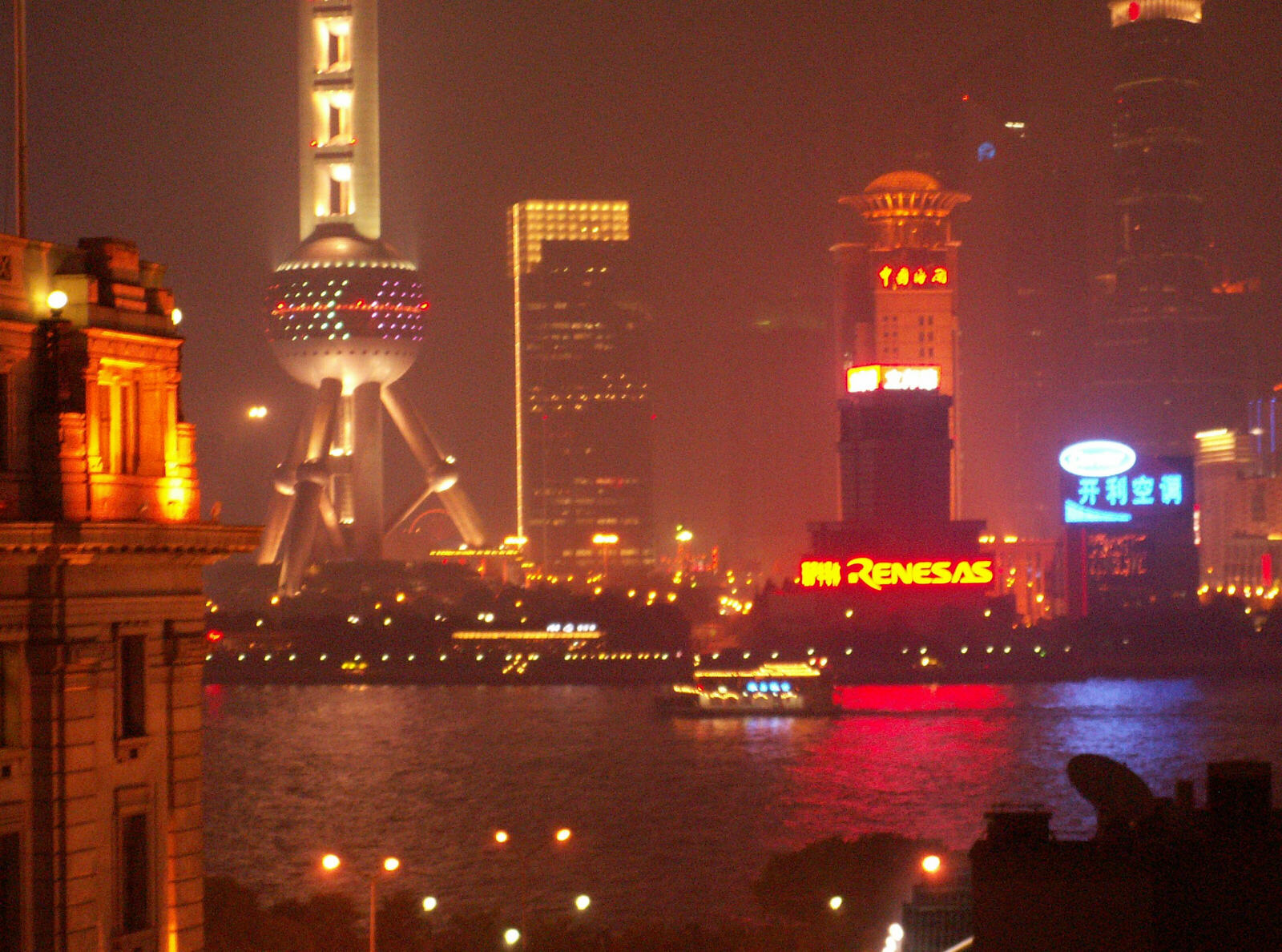
|
Then back to Yuyuan for a Chinese meal in a fancy restaurant by the lake in the centre of the bazaar which had photos of all the famous people who had eaten there, including President Clinton. The food was good but the staff were surly and rude.
On Wednesday our tour of Shanghai started with cashing some travellers cheques at the Bank of China on the Bund, which was quite straightforward. Beside each cashier is a little push-button survey machine where you can register your satisfaction or otherwise with their performance, and a number of stars light up to show how well they have done today. We then returned to the Yuyuan Garden itself which was lovely, and included another lake full of huge Koi carp but unfortunately nowhere to buy fish food. |
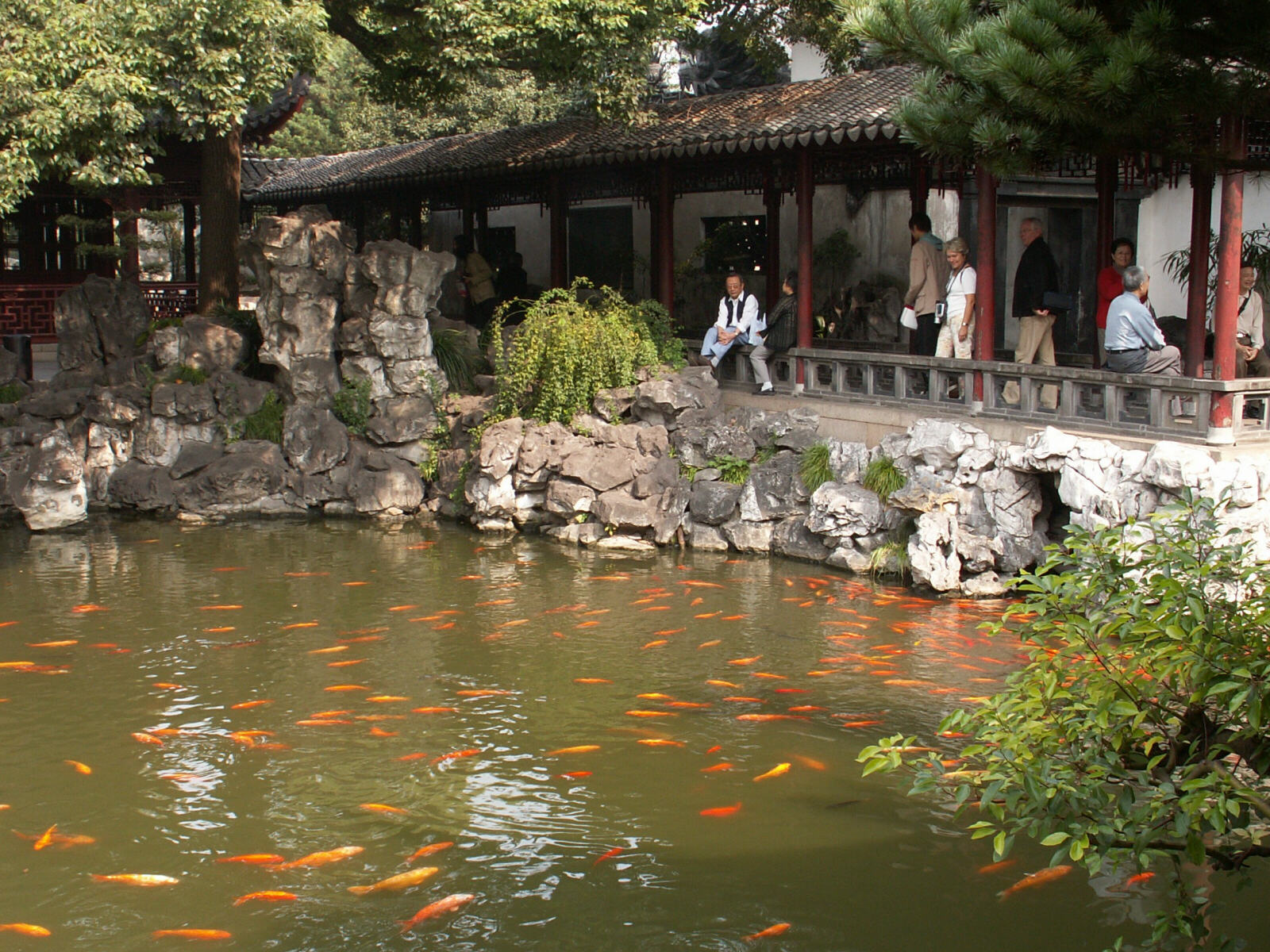
|
Just outside the gardens I went to the Huxinting tea house which upstaged the nearby restaurant by having a picture of the Queen sipping tea there. It was indeed extremely pleasant with a fascinating view from the upstairs window of all the people milling by on the bridge and in the bazaar. Meanwhile, Sheila queued up to buy the best steamed dumplings in China; the queue was over an hour long and ended at two small windows, one where you thrust in some money and the next where you receive a cardboard container full of dumplings. Inside, cooks were feverishly kneading dough, forming dumplings and taking bamboo containers in and out of the steamer. Nearby connoisseurs of steamed dumplings kept telling us they were the best, but to us they were only OK; we are not yet connoisseurs. Our leftovers were fed to the Koi carp, which had to be quick to catch them as the dough sank rapidly to the bottom. |
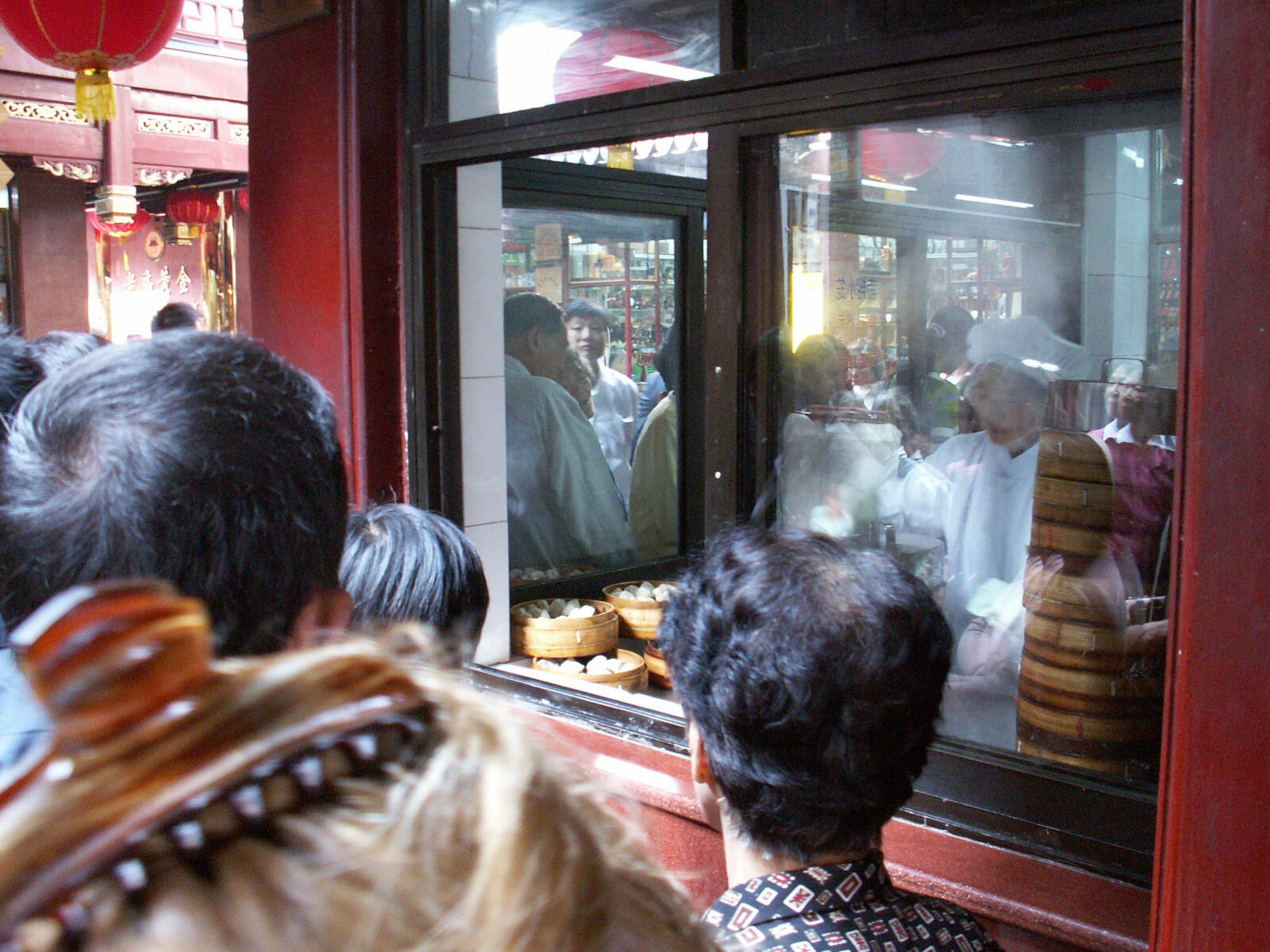
|
We went to the Jade Buddha temple in the northwest part of town. It was another picturesque, active temple and we were again lucky enough to arrive during a service as the monks went from hall to hall chanting, accompanied by bells and drums. |
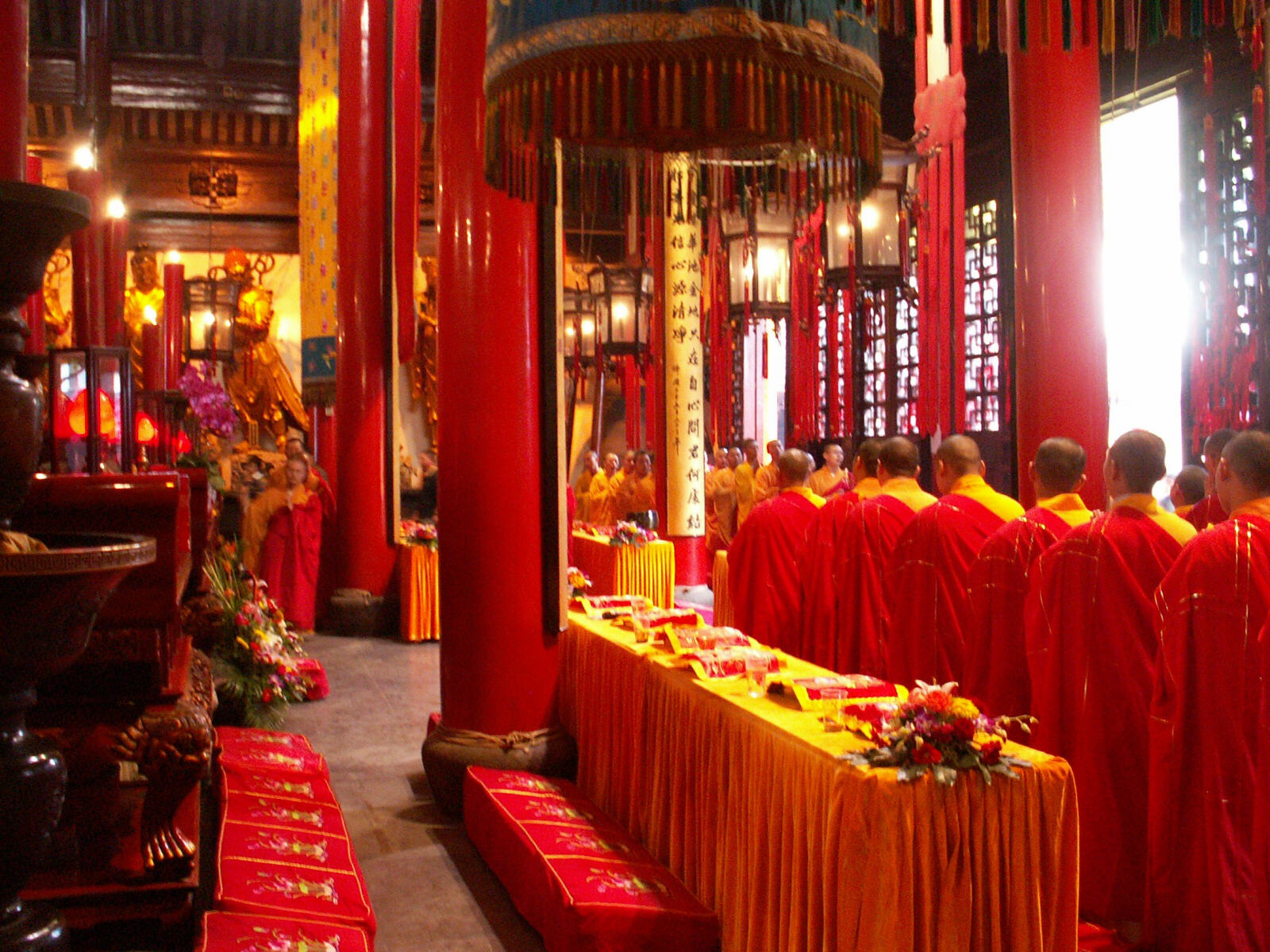
|
Back on the Bund we walked up and down the riverfront checking out the various boat trips on offer, then had another beer at the Captain's rooftop bar as the lights started to come on around the city. We now had serious withdrawal symptoms from not having an Indian meal for a week and a half, so in a 'dining out' guide we found the Indian Kitchen on Yongjia Road, which turned out to be absolutely wonderful.
We moved to the Astor House hotel on Thursday for our bit of luxury before we go home. It had been recommended by a couple we met in Datong and it was every bit as good as they described - slightly faded old colonial elegance, vast bedrooms with dark wood floors and huge doors. We were lucky enough to have a room at the front with a great view over the bridge to the Bund, as well as looking down on the Russian embassy! |
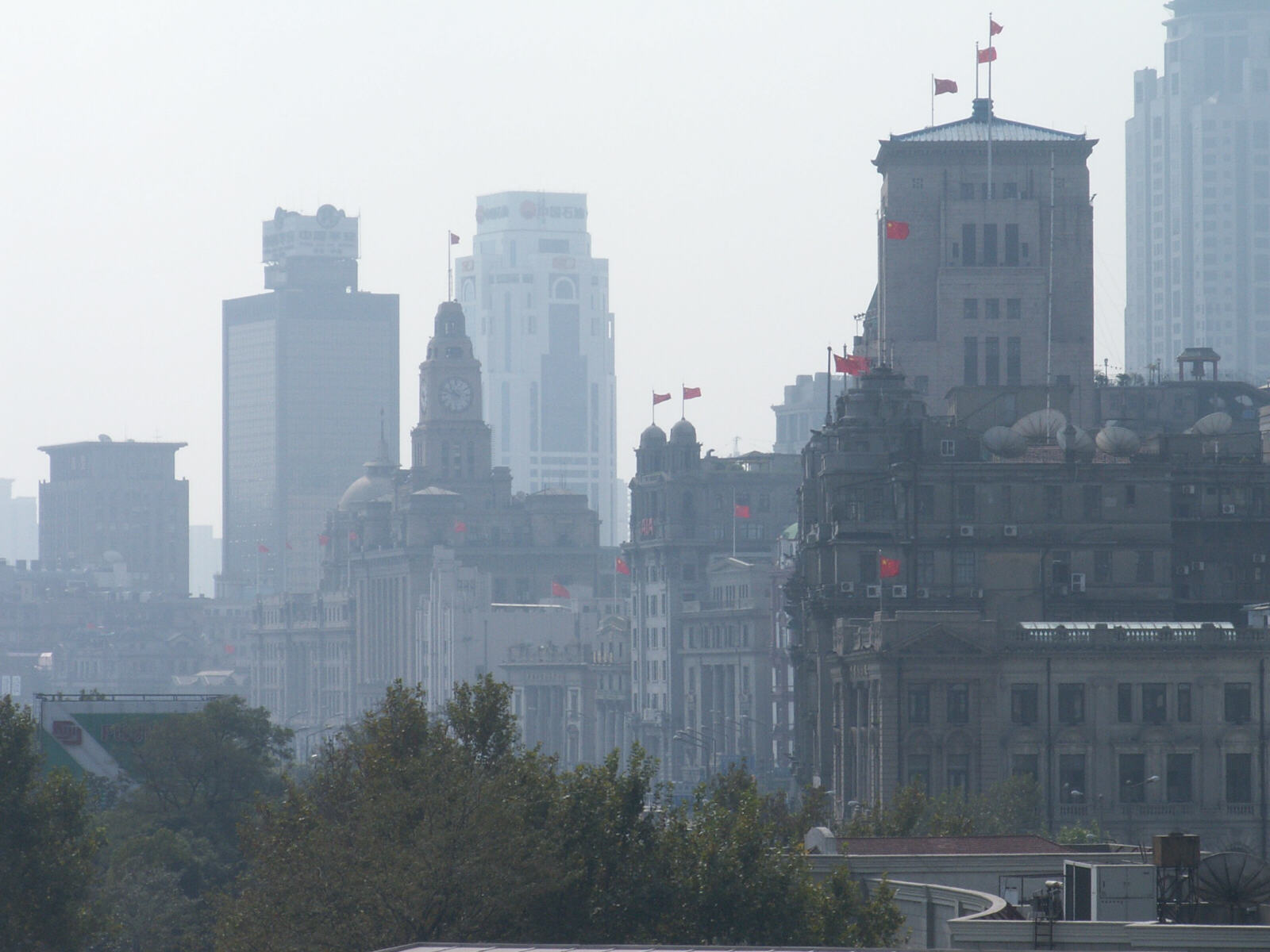
|
Like many of Shanghai's buildings the Astor House has had a chequered history. It was the first western-owned hotel in China and was the first building in China to have electric light. In the early 20th century it vied with the Cathay to be the 'grand hotel' in Shanghai, but it apparently closed in the Communist days because it re-opened in 1998 as a youth hostel with a Chinese name, and there is a picture of the great atrium filled with students' bunks. Now it is recovering its grand style and its original western name. We just flopped about in the room enjoying it for a while until we eventually dragged ourselves out to continue sightseeing. We walked down the Bund then caught the metro to Huaihai Road, a busy shopping area in the former French concession, where one or two old European-style buildings still survive amongst the brightly-lit shops and high-rise blocks. After another wonderful meal at the Indian Kitchen we went back to the Bund and had an evening cruise along the Huangpu river, past the fabulous new towers and blocks on the eastern shore covered in flashing multi-coloured lights and advertisements, and back past the more sedate, solid 1930s buildings on the western side. Just as we were walking down the riverfront towards the hotel, to complete our entertainment an impressive firework display started up from a boat in the middle of the river.
Our incredible run of good weather finished on Friday and we woke up to a gloomy raining morning. After breakfast (a mostly Chinese buffet with a nod at European tastes) it had stopped raining so we went back to Shanghai Old Street to wander round the shops. We interspersed this with forays down the side streets and winding alleyways to the south of the bazaar, to get a glimpse of the old 'Chinese Quarter' before the rest of it is bulldozed down to build high-rises or sanitised tourist attractions. It was fascinating, but probably not much fun to live there. |
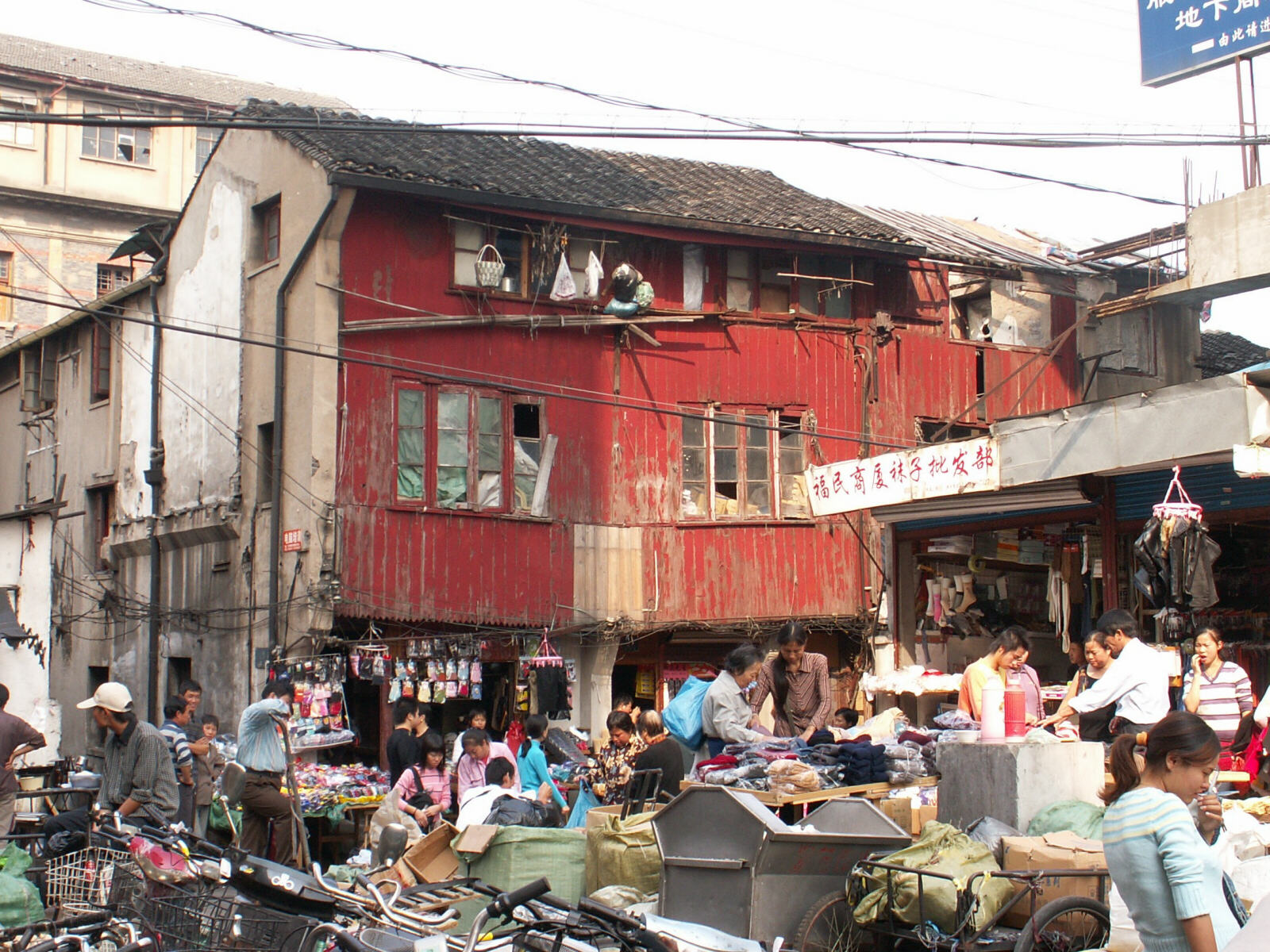
|
We also walked down to the river and found we were at a ferry dock, so for Y ½ (4 pence) we decided to see where it went - we were hoping it would go up and down the river but it simply went across and back, which was fascinating enough, because most of the passengers were on scooters and motorbikes and when the gate opened they all surged forward in a noisy, smoky mass. By mid-afternoon it was raining again and I went back to the Peace Hotel (Cathay Hotel) for afternoon tea. The Cathay Hotel was rather disappointing - you don't get the same 'grand old hotel' feel that you do in the Peninsula in Hong Kong or Raffles in Singapore. Nevertheless there is a little 'bakery' and tea shop on the second floor which was very pleasant. In the evening it was pouring down so we didn't walk about much, we just went back for another wonderful meal at the Indian Kitchen.
On Saturday as a final treat we were whisked out to the airport on the new Maglev train at an impressive 270 miles an hour (430 km), the fastest train in the world (a British invention, German built). Well it beats getting a taxi!
Walking the dog, Shanghai style.... |
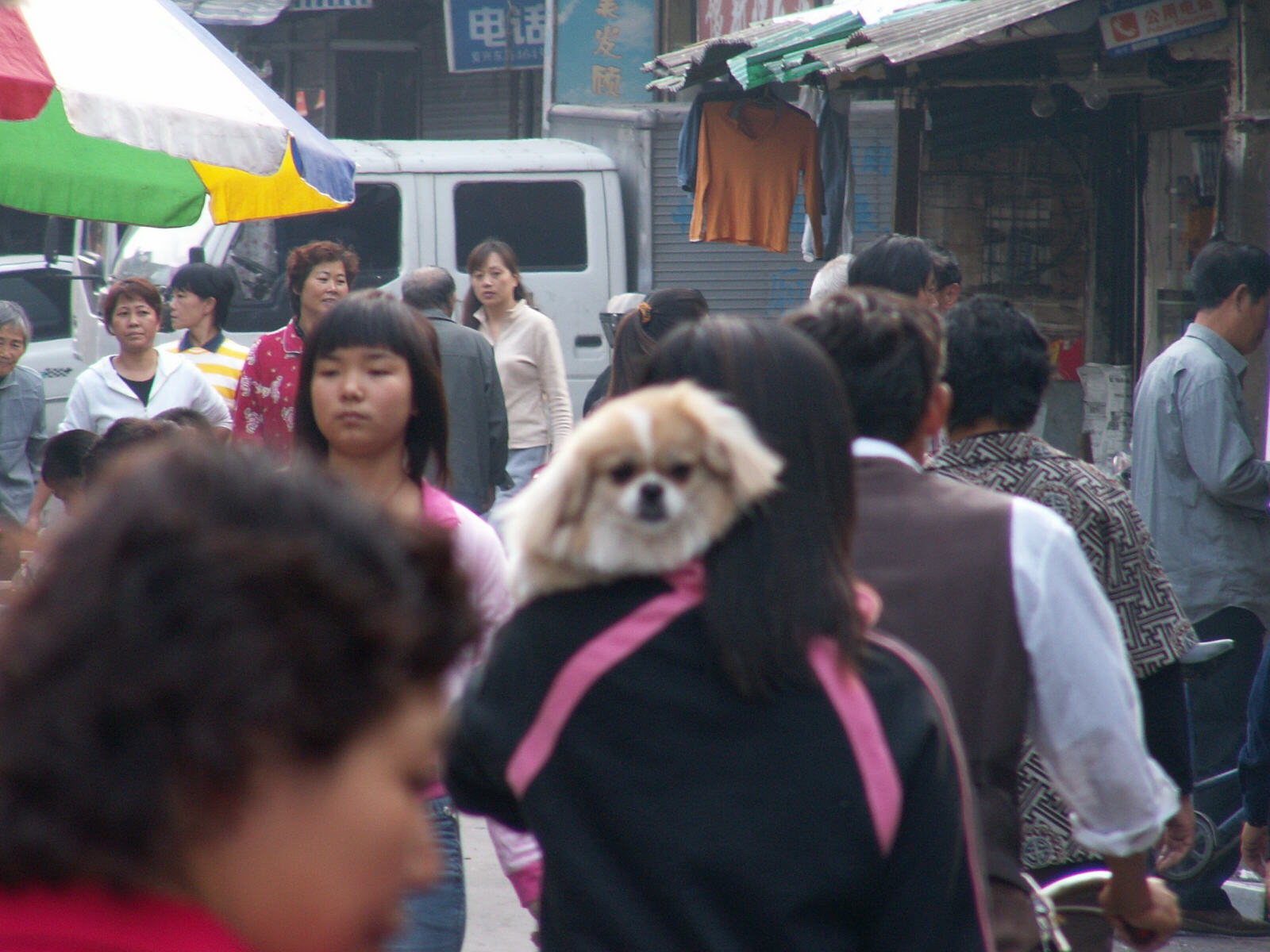
|
Last year we travelled from Beijing to Bangkok overland,
and back in 1980 we went by train from Bangkok to Singapore,
to complete the whole London to Singapore overland route.
If you would like to read about those or see more of our travels just click the map.

|